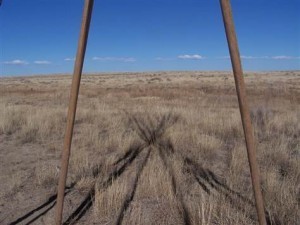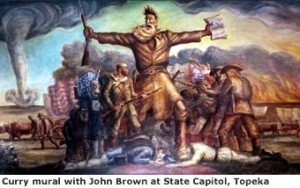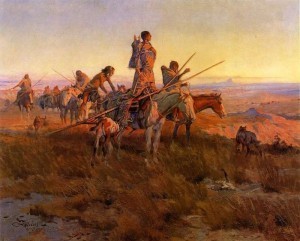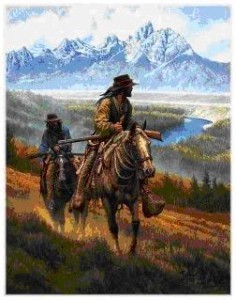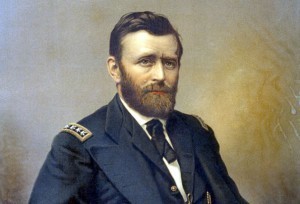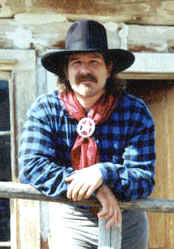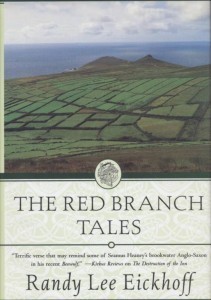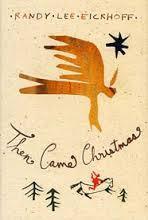Julia Robb's Blog, page 8
June 15, 2014
Greg Michno Balances Sand Creek and Indian Wars
 Hi Gregory Michno: I really appreciate this interview, as I know you don’t do many interviews. Also, I believe you are an invaluable historian because you are obviously not afraid of presenting politically incorrect facts and conclusions about American history.
Hi Gregory Michno: I really appreciate this interview, as I know you don’t do many interviews. Also, I believe you are an invaluable historian because you are obviously not afraid of presenting politically incorrect facts and conclusions about American history.This is particularly true in A Fate Worse Than Death: Indian Captivities in the West, 1830-1885 and Battle at Sand Creek: A Military Perspective.
In Fate Worse Than Death, you and your wife Susan, who co-wrote the book, are clear that being
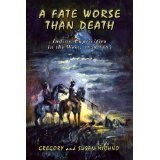 captured by Indians meant, if you were a woman, rape and/or gang rape, slavery and often torture and death.
captured by Indians meant, if you were a woman, rape and/or gang rape, slavery and often torture and death.In Battle at Sand Creek you present Sand Creek as a battle and not a massacre (which is the modern perspective), and present the whites’ point of view (which meant the Cheyenne living in the Sand Creek Village, or nearby, were raiding and killing settlers). Also, during the raid, the warriors at Sand Creek fought back, killing some soldiers.
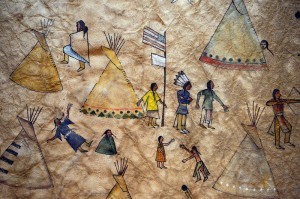 (Readers, Sand Creek occurred in 1864 when a 600 to 700-man force of Third Colorado (U.S. Volunteer) Cavalry attacked and destroyed a Cheyenne and Arapaho village in southeastern Colorado Territory, killing between 70–163 Indians, many of whom were women and children. At the time, the Cheyenne were discussing peace with the whites).
(Readers, Sand Creek occurred in 1864 when a 600 to 700-man force of Third Colorado (U.S. Volunteer) Cavalry attacked and destroyed a Cheyenne and Arapaho village in southeastern Colorado Territory, killing between 70–163 Indians, many of whom were women and children. At the time, the Cheyenne were discussing peace with the whites).Historians and tribal peoples usually believe the attack was an unprovoked massacre.
Q. Your book on Sand Creek is startling. Nobody else has written anything like it. Why were you interested in this subject?
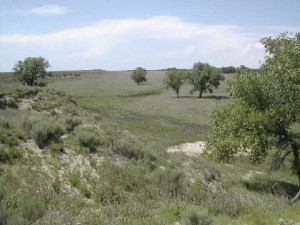
Sand Creek site
A. When you first present an inquiry to a publisher one of the first things asked is, “What is your target audience?” Without trying to sound flippant, my answer is always, “Me.” I only write for myself, to simply learn more about a subject that I find interesting. There are no hidden agendas.
There are a number of books written about Sand Creek, usually from two extremes. Of late, a decidedly pro-Indian, anti-soldier tone is in evidence.
So, I tried to learn for myself what happened, and, in a fit of unwarranted optimism, I believed I would be able to clear the waters with Battle at Sand Creek: The Military Perspective (Upton & Sons) in 2004.
I had the belief that presenting the evidence—the facts—would actually allow people to objectively evaluate the situation, make an educated assessment, and perhaps see the affair in a different light.

Since the incident has been almost universally portrayed as a massacre I tried to swing the historical pendulum more to the middle by illuminating the points that would lend credence to the minority view that an actual battle had occurred, albeit one that was accompanied by horrible atrocities.
Big mistake. I actually thought that facts would persuade. They don’t.
Q. You point out the Cheyenne, at the time Sand Creek took place, were holding white captives, had been raiding and usually made peace in the winter and made war in the summer. Are these facts correctives for the usual picture of soldiers destroying innocents?
A. The Cheyenne and Arapaho were raiding and killing all summer and into the fall of 1864. Now, as to who was to blame for “starting” it all is endlessly debatable, independent of the facts, and resolvable only through the preconceptions of the individual.
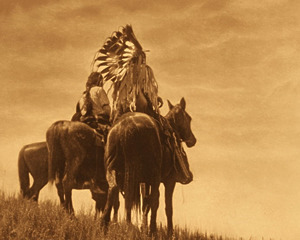
These Indians held seven white captives, which they admitted they had in their letter asking for peace. Soldiers tried to procure all of them, but were only given four, possibly a hedging by the Indians who figured it was not a good idea to give up all their bargaining chips.
Whether the peace request was a sincere desire, or a stalling action for the upcoming winter, we don’t know.
It seems accurate to assume, however, that the Cheyenne and Arapaho, after the Camp Weld Conference in September 1864, and with the assurances they were given by Major Edward Wynkoop, believed that they were reasonably safe.
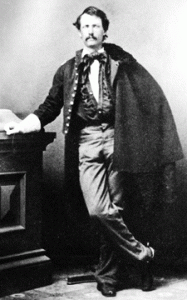
Wynkoop
Perception, however, is individually and group oriented. The village attacked on Sand Creek contained warriors who had been killing and raiding. Some will argue that they now had immunity, others will disagree.
Again it depends on individual biases and no amount of “facts” or reasoning will make any difference.
The village also contained women and children who had been doing nothing warlike except supporting their men. Were they legitimate targets? Were white homesteaders legitimate targets for Indian warriors?
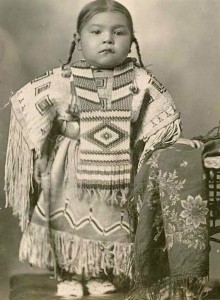
If I had my choice, I’d say leave the women and children out of it, but war has a way of ignoring personal preference.
One point that few people realize is that there were 76 white casualties at Sand Creek. It doesn’t sound like much, but it represents the sixth largest white casualty count in all the 1,450 fights between 1850 and 1890.
Some people will undercount the white casualties, just as others will overcount the Indian casualties.
A major factor involved is our “gut” reaction to the atrocities. Seventy-six soldier casualties is just a statistic. One pregnant Indian woman scalped and mutilated is the story we remember. That is human nature doing the talking.
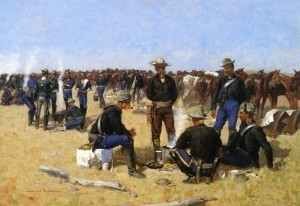
Cavalrymans breakfast on the plains, by Frederick Remington
Q. Did the soldiers deliberately murder women and children?
A. Certainly there were soldiers who deliberately killed women and children. There were also soldiers who saved women and children.
The eyewitness testimony has enough examples to prove that there were scalpings and mutilations. The record also has examples of soldiers who were appalled by the action and expressed their revulsion of it.
Some soldiers thought nothing of taking multiple scalps or mutilating bodies, but this was done by a comparatively small percentage of men, the likes of which one will find in any organization or sample population.
But depicting the entire Third Regiment as an army of ghoulish mutilators is nonsense.

Q. What do you think of commander John Chivington? Did he really say “Damn any man who sympathizes with Indians! … I have come to kill Indians, and believe it is right and honorable to use any means under God’s heaven to kill Indians. … Kill and scalp all, big and little; nits make lice.”
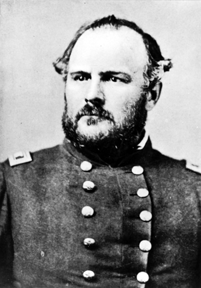
Chivington
A. I don’t care for the historical John Chivington one bit, but by trying to assume a non-judgmental position you cannot describe the man in terms of pure evil.
When I wrote Lakota Noon (Mountain Press) in 1997 I got some criticism as being too pro-Indian. Critics of my Sand Creek book said I was too pro-white.
Perhaps when you anger both sides you are doing something right.

Ari Kelman, the author of A Misplaced Massacre (Harvard University Press, 2013), represented me as a modern defender of Colonel Chivington, and apparently he saw everyone who defended some of the white settler and soldier actions as “culture warriors.” It is rather humorous.
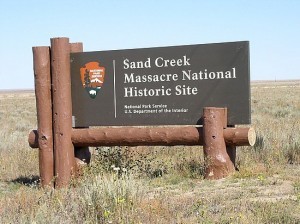 Chivington’s “Damn any man” statement comes to us from Lt. Joseph Cramer. His “nits” statement comes from District Attorney Samuel E. Browne, who claimed the colonel said it at a rally in Denver in September 1864. Both were Chivington’s enemies.
Chivington’s “Damn any man” statement comes to us from Lt. Joseph Cramer. His “nits” statement comes from District Attorney Samuel E. Browne, who claimed the colonel said it at a rally in Denver in September 1864. Both were Chivington’s enemies.Regardless, we have to accept the statements the same as we would the statements from Chivington’s friends. All of them have to be examined in light of other pertinent evidence, and then we can accept or reject it—but we should realize that the acceptance or rejection will stem from our own prejudices.
By the way, the “nits” phrase was common during the nineteenth century.
Denmark Vesey, a black freedman accused of plotting a rebellion in South Carolina in 1822, was also said to have uttered, “What’s the sense of killing the louse and leaving the nit?” when discussing killing all the white children.
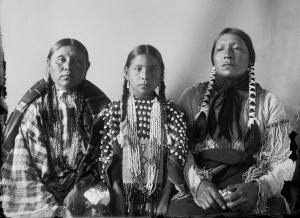
Scabby-wife-Walking-Woman-daughter-Bear-Woman-Cheyenne-1908
Q. Were you vilified for writing a politically incorrect version of Sand Creek?
A. Although I have used the terms “politically correct” and “politically incorrect” myself, I increasingly find them devoid of meaning. The correctness or incorrectness of a statement also lies in the eyes of the beholder.
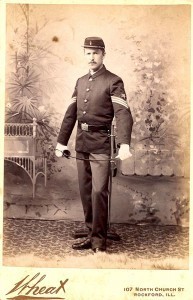
(Brevet General) Washington Lafayette Elliott, 1st U.S. Cavalry.
It is really an attempt at historical accuracy that supports, or undermines, another person’s expectations. One’s truth is another’s lie. That said, yes, I got flak for appearing to defend the white settlers and soldiers.
Q. Were you and your wife Susan attacked for writing about Indian rape against women captives?
A. No, at least not that I am aware of. I recall one review of A Fate worse Than Death that took exception to showing that members of some Plains tribes did rape female captives. The reviewer did not argue that it was untrue, only that he didn’t want to read about it. It offended his mindset.
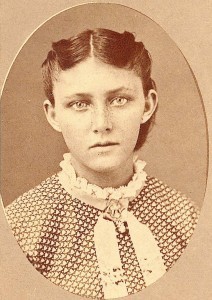
Catherine German, who was captured by Indians.
Although it would take additional examination, I would venture to say that the percentage of Indians who raped white women was small, and that their actions were not looked upon favorably by the majority of the tribe, just as in the case of the soldiers who mutilated Indians. Deviant behavior is not limited to any group.
Q. What do tribal peoples think about your work on Sand Creek and women captives?
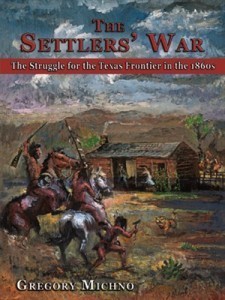
A. I don’t know. I don’t imagine a great many have read the books. Heck, not a great many of anyone has read them! But any people will take out of history what they put into it. They will read and see what they already are. Seeing is not believing; believing is seeing.
Q. Your books seem to be based on original documents. Are those difficult to find?

A. I try to use original documents when I can, but there are many secondary sources that are very helpful for the insights they provide. With the internet and with so many institutions putting their documents online now, original sources are getting much easier to find and access.
Historians love to attest to the reliability of eyewitness testimony and first-hand narratives. They may be better than stories written from faulty memories years later, but they are subject to the same faults and foibles.
We deceive ourselves into believing that the eyewitness participant will give us historical accuracy. That is part of the cautionary tale told in a postmodern world.
Q. Up until the 1970’s, books and movies depicted the frontier army as heroic. Since, the frontier army has been depicted as the bad guys. Why?
A. There have been numerous books that have studied this phenomenon. My wife and I talked a little bit about it in Circle the Wagons (McFarland, 2009). Part of it simply stems from the temper of the times, the Zeitgeist.
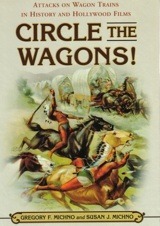
Our postmodernism world implies that universal truth is impossible, master historical narratives are out, and relativism is our fate. History is not progressive and knowledge cannot liberate. An objective view is untenable and borders on myth. History is little more than literature because all meaning is socially encoded and constructed, just as fiction is.
In the postmodern world, all disparate discourses have to fight for power against autonomous, holistic, master narratives. Postmodernism contributes to the growth of diverse cultural histories while at the same time working to dissolve the sense of history in culture.
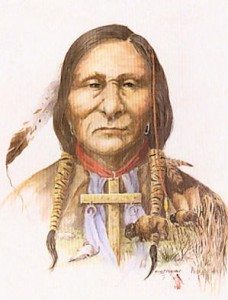
Chief Black Kettle who rallied many of his people around the American flag, believing the soldiers would not kill them.
This is a frightening picture for many. Positivism is long gone. Historical narrative cannot mirror past reality. Conservatives in particular denigrate postmodernism and link it to political correctness and multiculturalism almost as a new Communist enemy.
If you muddy the past, the nation’s collective memory short circuits. What would the American celebratory memory be if suddenly Daniel Boone, Davy Crockett, and John Wayne changed from wholesome, iconic heroes to fascist pigs? It is too scary a scenario for most traditionalists, but it has been happening and the process is ongoing.
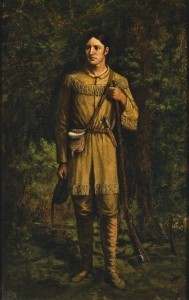
Davy Crockett, by William Henry Huddle
Postmodernism rejects the pattern, order, and security of a God-driven universe and leaves people believing that the alternative will lead to nihilism, atheism, or chaos.
Yet, this is the world we are living in. The old frontier heroes are now the bad guys. Does it mean we are regressing, or growing up?
Q. Can you tell me something about your background?

Gregory Michno
A. It’s thoroughly non-descript. I am a Michigan native and lived there for most of my life. Attended Michigan State University and the University of Northern Colorado. I spent nearly thirty years working for the State of Michigan in the Human Services Department. I decided to take up writing history, more or less as a hobby, back in 1990. Why? Just as I said earlier: simply to learn more about things I was interested in. My wife and I currently live in Colorado.
Q. What are you working on now?
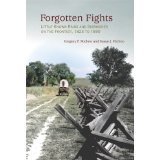
A. I have actually just completed two manuscripts, and am in the hunt for publishers. One is completely out of my “normal” area of interest: From Witchcraft to Christcraft: The Devilish Beginnings of Evangelical Christianity and the New Witches. It is more or less a history of American persecution, first of white “witches”—through escalating violence many times fueled by religious fervor—to black “witches,” red ones, Communists, and Muslims.
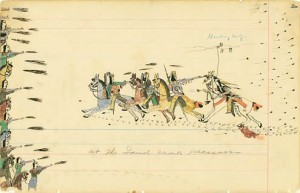
Painted by Sand Creek witness Howling Wolf.
I have also just finished The Three Battles of Sand Creek: In Blood, In Court, and As the End of History.
In effect, it is a history book about the impossibility of writing accurate history.
This one has a strong postmodernist flavor, which has elements of some of the points I have covered in the above questions: the realization that there are no facts, we invent them in our memories, our memories are often false, we make poor eyewitnesses, we fall for suggestions, we do just what the rest of the herd does, we are slaves to our prejudices, cognitive dissonance rules our actions, confirmation bias blinds us, we filter the world through our individual lenses, and assuredly we never let truth get in the way of what we already think.
Evidence will never change our minds.
Maybe the only thing a historian can do is provide a historiographical survey of the various sources and let the reader choose which one fits his own biases most comfortably.
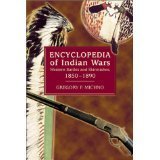
We might say that nothing has ever happened. There are no facts. There are only our interpretations of them, all filtered through individual lenses, bounced like a pinball through the synapses in different areas of our brains, and true only for the one doing the filtering.
After the “facts” have been either consciously or unconsciously deformed by the participants and the historians, the reader gets to apply the same mechanisms to her own peculiar system.
Then you get the book review.
The post Greg Michno Balances Sand Creek and Indian Wars appeared first on Julia Robb, Novelist.
June 1, 2014
Jeff Barnes Says Custer Was Not A Bad General

Jeff Barnes
Hi Jeff Barnes: I’m impressed. You’ve not only written three books–on Custer, Buffalo Bill and High Plains’ U.S. Army forts–you’re a fifth generation Nebraskan and based your entire career on your native state (which is rare in modern day America). You were a reporter and editor, among other things, and are now a freelance writer and historical speaker.
I’m dying to know about Custer.
Q. Why did you write a book about the most written-about general in American
 history?
history?A. My Custer book started as “Forts of the Southern Plains,” a follow-up to my first book about the Northern Plains forts. I attended an OIW conference in San Antonio while also doing some research on the forts down there, and Robert Utley was the keynote speaker. One of the bits of knowledge he shared was “If you want success as a writer, write about people who people know.”
On the long drive home, it occurred to me that Custer had visited many of the forts I was researching; I’d also be able to include his battles and other sites on the plains and get into more of the personality aspects. There were many books out there about Custer, but no one had done a historical travel guide so that would be my hook.
Finally, it allowed me to speak about his time in Nebraska and have speaking opportunities here – I couldn’t have done that with a southern-plains fort book.
 Q. Many people believe Custer was a psychopath and a disastrous general. You don’t seem to feel the same way.
Q. Many people believe Custer was a psychopath and a disastrous general. You don’t seem to feel the same way.A. Unfortunately, many folks draw their history from popular culture or the biased opinions of others. My own cousin – when I told her I was writing a book about him – said “I hate Custer,” and I know she hadn’t cracked a history book in more than forty years!
He certainly wasn’t a psychopath – the Army didn’t keep those commanders in the field.
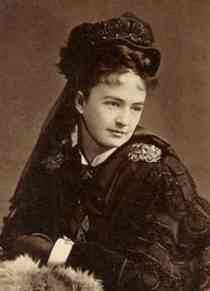
Libbie Custer in her mourning clothes.
(Gen.) Ranald Mackenzie was probably the most successful commander of the Indian Wars and he was retired quickly enough when he showed signs of his deteriorating mental condition.
I wouldn’t call Custer disastrous, either – he had had success on the plains and Sheridan and Sherman fervently wanted him on the 1876 campaign. He came into a disastrous situation, but it wasn’t one of his making.
I don’t know if ANY Army commander active at the time could have found success at Little Bighorn, but I do think Custer had the best chance of it.
Q. Are people ever surprised you don’t believe Custer was a bad general?

The Little Big Horn River
A. No, or they wouldn’t if they stuck around to discuss him with me! Quite often people will make a short declarative statement – “Custer was a coward!” or “Custer was an idiot!” or “Custer shouldn’t have split his troops!” – but they leave quickly if I ask them why they believe that, or if I offer a counterpoint.
People do not like their beliefs challenged, and I’ve become a pretty good “devil’s advocate” for him.
I wouldn’t call myself a huge Custer fan. If you read The Great Plains Guide to Custer, you’ll see that I present his flaws as well as his virtues – I try to present him honestly and without bias.
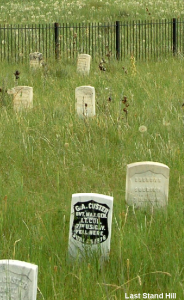
The spot Custer fell.
I was a newspaper reporter of the “old school,” meaning I didn’t approach a story with an agenda – I sought out both sides, presented the facts, and let the reader decide for himself. The book is kind of my attempt to understand Custer, rather than an effort to get the reader to see him the same way I do.
There are things I admire about him, and things I don’t, but Custer is fascinating and deserving of study.
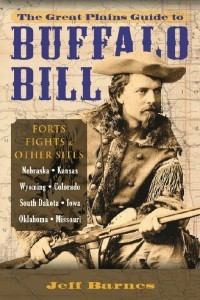 Q. Why did you write about Buffalo Bill Cody?
Q. Why did you write about Buffalo Bill Cody?(Readers, Cody was born near LeClaire in Scott County, Iowa in 1846 and lived until 1917. He was only 14 when he began riding for the Pony Express. He fought for the Union in the Civil War, then worked as a scout for the Army. Thanks to dime novels written by authors like Ned Buntline, Buffalo Bill was already an Old West legend before mounting his famous Wild West show, which traveled the United States and Europe. He earned his name by killing an amazing number of buffalo).
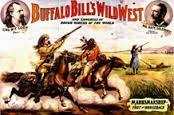 A. I enjoyed getting into a larger-than-life character with George Custer and adapting him to a historical travel guide, and Buffalo Bill Cody offered all of that again. Plus, his ties to Nebraska were even stronger, with his Medal of Honor, his founding of the Wild West show, and his establishment as a true American legend.
A. I enjoyed getting into a larger-than-life character with George Custer and adapting him to a historical travel guide, and Buffalo Bill Cody offered all of that again. Plus, his ties to Nebraska were even stronger, with his Medal of Honor, his founding of the Wild West show, and his establishment as a true American legend.Q. What is the most interesting fact about Buffalo Bill?
A. He was the most famous man in the world at the end of the 19th century – you could mention his name or show his photo and virtually everyone knew who he was. He went from being a long-haired army scout to become the world’s first superstar. He did it in less than 15 years, from Nebraska, and that is truly amazing.
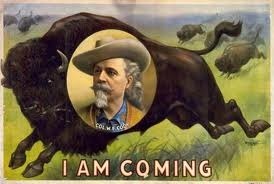
Buffalo Bill poster advertising his show.
Q. There are many stories about Buffalo Bill killing Yellow Hair (a Cheyenne). Did it really happen, and if it did, what exactly happened?
A. Cody and several others were on the hill overlooking the scene when the first Indians from the Red Cloud Agency appeared. Cody and five or six others rode out to intercept the leaders. A signalman watching this with aid of a telescope said the two groups seemed surprised to see each other. Cody and the lead Indian (Yellow Hair) fired on each other, with Cody hitting the sub-chief’s leg and horse and the Indian missing. They both fired again, with the Indian missing once more and Cody’s shot killing the Indian.
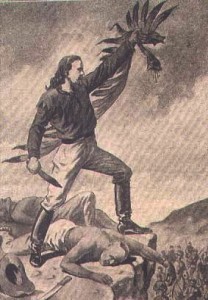
Buffalo Bill taking Yellow Hair’s scalp.
Cody took Yellow Hair’s scalp, war bonnet, shield, bridle, whip and weapons. He supposedly shouted “First scalp for Custer!” but that may have been added for the stage production of this event.
There were claims that someone else did it or that it never happened, but those claimants usually weren’t at the fight.
Q. Did your interest in Nebraskan and Western history develop because you have such deep roots in the state, and the region?
A. It certainly helped! It actually developed in a round-about way.
I have a group of friends with whom I wargame – reenacting battles on a tabletop with little lead soldiers. We became focused on the American Civil War and I had a great-great-grandfather who fought for the Union, so I became interested in visiting his forts and battlefields, as well as others back east.
When I ran out of those sites, and knowing many of those Civil War commanders came to the West, I began visiting what was in my own “backyard.” They’re much closer and just as fascinating.

Fort Mitchell, by William Henry Jackson
Q. How did you learn enough to become a speaker?
A. I didn’t set out to be a speaker and I was a bit scared the first time out, but I knew the only way to sell books was to get out and talk about them. I’m a trivia nut and have a habit of picking up odd bits of info everywhere; I find that the things about history that have surprised and impress me do the same for people who come to my talks. I don’t use a script, so sometimes it’s really tough to keep them under 45 minutes!

Q. How does it feel to be part of a place for five generations?
A. It’s a great feeling. I love Nebraska – our kids are within 15 minutes and have given us three seventh-generation Nebraskans.
 Q. Have you ever wanted to live anywhere besides Nebraska?
Q. Have you ever wanted to live anywhere besides Nebraska?A. I quit a radio DJ job after college to go hitchhiking to the Montana Rockies after reading Jack Kerouac and Steinbeck’s Travels with Charley. If the Great Falls Tribune had hired me I’d have stayed there, but Nebraska is my home.
Q. What are the five most interesting facts you’ve discovered when doing historical research?
A. Never thought about that, so I’ll just keep it local.
* That Custer had spent at least a day in my hometown of Omaha. I have a 1957 letter from NPS historian Merrill J. Mattes saying that Custer was never here, but my research of 1872 newspapers proves otherwise. I was also able to ID the place and date of a Custer photograph from that research.
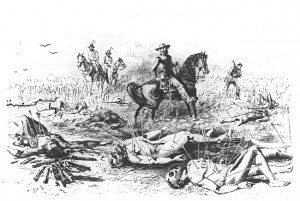
Custer and the Seventh Cavalry inspecting the remains of the Kidder Patrol, in Kansas.
* Omaha was a hotbed of military posts. From the first fort on the Great Plains (Fort Atkinson) to the last (Fort Crook), there were six military posts built within a 15-mile radius over 75 years.
* Custer’s “first stand” against Indians was in Nebraska on the Republican River. The date was June 24, 1867 – nine years and one day before his “last stand.”
* Buffalo Bill’s Medal of Honor was achieved here, about an hour north of North Platte on the South Loup River, near US 83. I’m now working with the state historical society to get the site marked.

* That the birthplace of Buffalo Bill’s Wild West Show in Omaha was just a few blocks from MY birthplace. (Neither site is marked today.)
Q. Have your books sold well?
A. “Well” is a relative term, but for the niche I’ve carved out, it’s OK. Like anyone who has written a book, you wish it would sell more. Forts of the Northern Plains, my first, continues to sell in its sixth year – it’s now in its fourth printing. The Custer book is in its second printing after two years and the Buffalo Bill book has just been out three months.
Q. What are you working on now?
A. It’s a small book about a baseball field in Rushville, Nebraska, that served as baseball school and try-out camp for the Milwaukee Braves, the New York Yankees, and the Los Angeles Angels in the ‘50s and ‘60s. I was hired to write it, but it’s another one of those wonderful little hidden historical secrets about this state.
Jeff’s website is: http://www.northernforts.com 
The post Jeff Barnes Says Custer Was Not A Bad General appeared first on Julia Robb, Novelist.
May 17, 2014
Kathleen & Michael Gear Unveil Cahokia

Kathleen and Michael Gear are archeologists who’ve been writing novels about “North America’s Forgotten Past” (before Christopher Columbus) since 1987.
Now they have a new novel out, published just a few weeks ago: People of the Morning Star.
Star is about Cahokia, a city (circa 1050 A.D.) that once stood where St. Louis is now located.
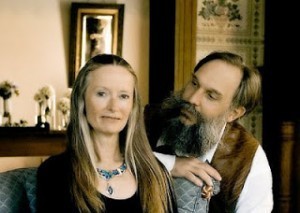
Kathleen and Michael Gear
Cahokia was so large the Gears believe it extended thirty miles in all directions and featured 10-story buildings.
Archeology confirms all the Gear’s major points about Cahokia, but the Gears go one step further.
They believe Cahokia suddenly expanded by tens of thousands of people (up to 100,000 or more), beginning somewhere in the 1050s, because people living in the region believed a religious miracle had occurred: That a god, Morning Star, had taken human form and was living in Cahokia.

The 1054 supernova
And the Cahokians believed this due to, among other things, the supernova which appeared in the sky over North America in 1054 A.D.
But in the novel, all is not well in the new city.
“To the astonishment of the ruling clan, an attempt is made on the living god’s life. Now it is up to Morning Star’s aunt, Matron Blue Heron, to keep it quiet until she can uncover the plot and bring the culprits to justice,” the Gears said.
If Blue Heron can’t catch the would-be assassins, Cahokia will be torn apart by civil war.
Thank you Kathleen and Michael for answering my questions.
Q. How do we know Cahokia grew so rapidly?
Like so much of the book, this is based on the archaeology. We can date the

Cahokia mural
establishment of the settlements through both carbon 14 dating and the arrival of pottery styles from other parts of the Midwest that have been previously dated.
And starting in the 1050s entire villages from five surrounding states picked up lock, stock, and barrel and relocated to Cahokia, bringing their culture with them. Archaeologists excavating at contiguous sites find pottery from Missouri next door to a site containing pottery common to Indiana. If both sites date to 1070, they have to be contemporaneous.

Cup related to the use of the leaves of a holly tree in a drink used for ritual purification ceremonies
The scene where Clan Keeper Blue Heron is investigation the brutal murder of the “dirt farmers,” where body parts are scattered around the house in a bizarre ritual, illustrates the problems Cahokians had. None of the local farmers even speak the language.
In explaining this phenomenon, we have to ask which human behavior would explain such an anomaly.
Economics is an unsatisfactory explanation since most local economies were quite functional. Nor do people casually leave the land of their ancestors.
Religion, however, is a powerful motivator, especially in a shared mythological cosmology.
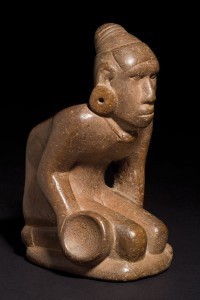
This 9-inch-tall stone depiction of a chunkey player about to release his stone was discovered in 1900 near Ocumulgee, Oklahoma. It was likely carved in Cahokia itself.
Evidence for this is found in the iconography, the religious art, recovered from Cahokia, its colonies, and trading partners.
Carvings on shell, stone statuary, and copper effigies undergo a renaissance at Cahokia and spread across the Eastern United States in the Cahokia period.
Additionally, the game of chunkey, which plays such an integral role in the novel—Morning Star plays every morning, perpetually winning and graciously refusing to take the loser’s head– seems to be a major clue. All those people who immigrated to Cahokia begin playing chunkey, making the gaming pieces from clay. They weren’t playing the game at home.
(Chunkey players throw spears at a rolling stone).
Chunkey was still being played when the Europeans arrived in the 16th Century; it always had a religious component.
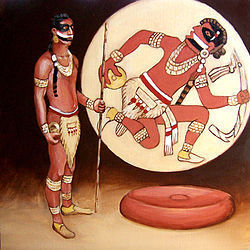
Illustration of a chunkey player based on a Mississippian gorget design. Artist Herb Roe
Finally, stories about Red Horn, the Morning Star, are found throughout disparate cultural groups who are the cultural descendents of the Cahokian world.
In the stories, Morning Star plays chunkey with the giants who murdered his father. He wins in the end, bringing his father back to life.
That becomes the enigma of Morning Star in the novel.
Fire Cat (one of Star’s main characters) thinks (Morning Star) is a fraud. Everyone else thinks he’s the reincarnated god. We leave it up to readers to make up their own minds, but we have recreated him based on the recorded mythology.
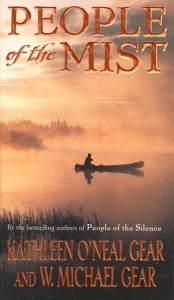 Was the 1054 supernova coincidental? Perhaps.
Was the 1054 supernova coincidental? Perhaps.
But consider that Cahokians, like all Native cultures, were inveterate astronomers who believed the Sky World influenced their destinies. The entire site (of Cahokia) is set up as a reflection of the cosmos, each mound aligned with a star, the path of the sun, and the eighteen-point-six-year cycle of the moon.
That supernova burned brightly, day and night, for all to see and wonder at its import. And then, if you heard the god had come to earth?
Q. Why would such an event inspire so many people to immigrate?
Resurrection was a universal concept across Eastern North America, perhaps dating back to the Hopewellian period five hundred years earlier. Historically it was still a driving belief in the Iroquoian “Mourning Wars” where captives were taken for the express purpose of resurrecting a dead relative’s soul into the captive’s body.
It played a role in the Pawnee “Morning Star” ceremony where a young woman was sacrificed, and it lies at the core of the Plains sun dance. The best source of information for the reader is Robert Hall’s ground-breaking An Archaeology of the Soul: North American Indian Belief and Ritual published by the University of Illinois Press.
Now, ask yourself, what would the effect be if Jesus were reliably reported to have returned to Jerusalem? Wouldn’t millions of believers flock to the city to see the savior? It would be an international sensation, drawing throngs from all over the globe. We have recreated this

Cahokia mural
sense of wonder in the crowds flocking to the grand plaza each day.
And that becomes part of Morning Star’s character in story. He’s miraculous, always opulently dressed with his painted face, shining copper headpiece, and elegant fabrics. At the same time, he’s vulnerable and escapes assassination by a gnat’s whisker.
His power comes from the sky, placing him in direct opposition to his sister Night Shadow Star and her possession by the Underworld. We just never know who he really is, or where he’s coming from: A continuation of an unsavory past, or a divine presence on earth?
Q. Could Cahokia be related to the Aztec capital at Tenochtitlan (now Mexico City)?
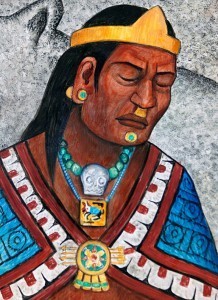
Aztec emperor Nezahualcoyotl, by Diego Rivera.
Tenochtitlan wouldn’t be founded for another four hundred years. However, there are parallels between the Morning Star myth and both Mayan and Mixtec mythology.
Our problem in North American archaeology is that we don’t find either traded artifacts from Mexico, or the skeletons of individuals of Mesoamerican ancestry. This is currently one of the biggest puzzles in North American archaeology. Why not?
We know Mexico was trading with the Southwestern cultures like the Hohokam and Chaco, but the only Mexican artifact found east of the Rockies is a single obsidian piece from the Spiro site in Oklahoma. Recently cacao has been reported recovered from Cahokian pottery, although peer review has its doubts.
We’ll deal with this in the next novel in the series when an exiled Cahokian lord appears with Mesoamerican goods and a new religion.
Q. What happened to Cahokia? Why did it fall?
Our best information hints at a combination of soil exhaustion and climate change. Cahokia was built during what’s called “the Medieval Warm Period” when the climate warmed and rainfall was plentiful.
In the 14th Century the world entered what’s known as the “Little Ice Age,” which lasted into the 19th Century. By 1400, every major North American civilization was in collapse. The effect was so great in the Cahokian area that by 1500 archaeologists refer to this as the “Vacant Quarter.” By that date the epicenter for culture had shifted to the Southeast and the great nations of Cofitacheque, Coosa, and the Apalachee.
Q. Was Cahokia a barbaric culture?
Perhaps by modern standards. Our modern world is a thin veneer overlaying and to some extent controlling the human universal of violence.
Compare Cahokia with Europe at the same period of AD 1000. The Vikings were slaughtering people throughout Europe. France, England, Italy, and the German states where locked in bitter civil wars. Butchery was everywhere.
Given a choice of living in London at the time with its excrement-filled, muddy streets, or Cahokia as described in the novel, which would you choose?
The final take away is that Cahokia was actually a more stable and safe society than many of its contemporaries.
In writing all of the “People” books, we’ve stuck to the data. Our novel People of the Moon was based on the collapse of the Chaco empire in the Southwest in the twelve hundreds. Though criticized for being too violent, we actually watered down the descriptions of warfare, murder, and cannibalism.
In reality, the Cahokian world was relatively peaceful, which makes Bead’s actions even more of an aberration and that much more villainous.
Q. What was the purpose of the mounds, and what’s inside them?
Mound-building in North America has ancient roots. The first mounds were being built in the lower Mississippi Valley some six thousand years ago, fifteen hundred years before the first Egyptian put one stone atop another to erect a pyramid.
Over the millennia mounds became the repository of the dead, a symbol of Mother Earth rising to Father Sky, observatories, centers for ceremony, and representations of the cosmos on earth. Everything in a mound and its construction had religious significance right down to the color of soil each layer was constructed with.

The mounds today.
To give the reader an understanding of mound construction we used Chapter 13 illustratively when Columella, High Dance, and Flat Stone Pipe are plotting and discussing the complexity of the threat posed by Clan Keeper Blue Heron.
At Cahokia, mounds had different functions. Some were communal tombs, others the foundation for temples, palaces, and charnel houses. We know, for example, that soil cores reveal a thick layer of stone lying in the heart of Monks Mound at Cahokia, but having never excavated it, we don’t know if it’s a tomb, a pavement, or other structure.

The Monks Mound as it was when Cahokian culture was at its zenith.
Today, when you go to a mound site, all you see is a pile of dirt. But for the people who built them, they had a special significance, which provides fodder for the novelist.
And makes a pretty good place for Night Shadow Star and Fire Cat to hide after Bead ambushes her in the middle of a dark and stormy night in Chapter Twenty-nine.
Q. When did archaeologists discover the mounds?
The first Europeans found Native peoples still living on them. Descriptions were made of the mounds and their purposes by the de Soto expedition and it’s successors and by the French in the Mississippi Valley.
For the English colonists who landed on the upper Atlantic coast where mounds weren’t built, they were an enigma encountered on the movement inland. By then the nations who built them had been decimated or destroyed by war and plague.
To explain mounds, the English adopted stories of the lost tribes of Israel, Modoc and his lost Welshmen, and Joseph Smith even used them for the basis of a new religion.
The first “scientific” excavation of a mound was by Thomas Jefferson, who correctly interpreted it as a Native construction.
As you’ll note from the modern introduction with John Wet Bear–where the film crew is claiming “alien” origins for Cahokia–we’re still fighting this racist and insulting myth. The underlying assumption to all the “alien” hypotheses is that the Native people were too stupid and benighted to have built these great monuments. Even aliens is preferential to crediting the construction of such sites to indigenous peoples.
No wonder John Wet Bear took a revolver with him on his way to Cahokia.
Q. Are modern peoples (Indians) descended from the Cahokians?
One of the points of using John Wet Bear and his uncle Max in the modern introduction is that yes, the Osage, Ponca, Omaha, Quapaw, and Kansa, appear to be the direct descendants of the Cahokians. Cahokian cosmology is even reflected in Osage ceremonialism.
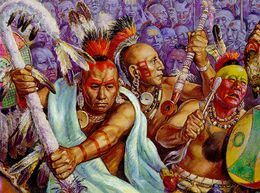
Osage Indians
One of the points we make with the modern introduction in all of the “People” books is that archaeology isn’t an abstract lost to the dim passage of time. Instead, the past is about the modern world and how it came to be.
Q. Were the mass, sacrificial graves mentioned in the book based on actual archaeological discoveries?
Yes, indeed. For a complete description see Melvin Fowler’s The Mound 72 Area: Dedicated and Sacred Space in Early Cahokia Illinois State Museum Reports of Investigations, No. 54. In the novel we tie these ridge-mound sites to resurrection events, acting as they did as theatre for the Underworld.
Q. How are book sales?
People of the Morning Star is only in its second week of release as of this writing. Given the collapse of the publishing industry, and the fact that we’ve lost eighty percent of the retail space for books in the last decade, we’re encouraged by the response so far.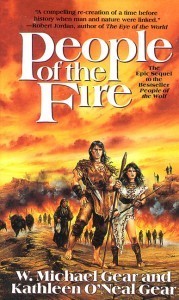
Q. What do you think of the ebook revolution?
Like all such innovations, it’s a mixed bag. Books are rather unwieldy things to lug around, especially if you have to tote more than one. Having an entire library on a compact device is a miracle. For some people, it allows them to continue reading. Michael’s eighty-two-year-old mother can enlarge the size of the print which allows her to continue her favorite pastime.
On the down side, publishers used to be the gatekeepers. They sifted through the thousands of submissions looking for quality writing, plotting, character development, and that special quality that made a story worth reading.
Today anyone can “publish” their e-format novel in a vast ocean of titles, no matter what the quality of the writing.
So, it begs the question: how do you find the good stuff in a cornucopia of mediocrity?
Additionally, writing has never been a high-paying occupation. At least with real books, publishers could be audited, and authors were generally compensated fairly for their work. With our ebooks, we’re just asked to trust the vendor–take their word on sales with no way to verify if they’ve sold ten copies, or ten thousand.
Over the last decade we’ve watched so many talented writers simply throw their hands up and quit, saying, “Why should I invest a year of my life in a novel when I could make more working the register at a convenience store for minimum wage?”
And finally, here’s a question no one has answered: What happens if the electricity goes off: If we have an EMP or solar flare that boogers the integrated circuitry? As archaeologists who’ve studied the collapse of cultures for decades now, we can tell you, someday, the electricity will go off.
Q. How did Cahokia feed its teeming throngs?
As you read the novel, you’ll notice that the domestic areas all contain gardens. Blue Heron notes the number of trees being taken down by the “dirt farmers” to clear fields and the numerous mentions of farmsteads. Every bit of arable land–in what is still the breadbasket of North American agriculture–was put into cultivation. That’s another reason for Cahokia’s immense size. Much of it was fields.
At the same time, Cahokia was strategically located at the confluence of the Mississippi, Missouri, Illinois, and Ohio Rivers, and we know these people relied on extensive river commerce. In return for Cahokian trade in manufactured goods, they could tap into the food surplus from four major water sheds.
Consider the opening scene when Bead’s canoe comes ashore at the river landing. Goods of all kinds are being transshipped to feed Cahokia’s ravenous appetites.
Q. How do we know the name of the city, as the Cahokians did not have a written language
We don’t. Cahokia was named after a band of Illini who were living in the area when August Choutou founded the city of St. Louis. Perhaps they took the name of the fabled city as their own? Or they didn’t.
What matters to us is that People of the Morning Star contributes to the modern reader’s understanding of the vastness and complexity of Cahokia, and its place as one of the great archaeological sites in the world. And it’s right here, literally in our own backyards.
The post Kathleen & Michael Gear Unveil Cahokia appeared first on Julia Robb, Novelist.
May 10, 2014
Mother’s Day–Stories by Wiseman and Robb
 Two weeks ago, I challenged Kirby Jonas to take the Short Story Challenge: write 800 words or less.
Two weeks ago, I challenged Kirby Jonas to take the Short Story Challenge: write 800 words or less.
This week I upped the ante: I challenged my friend Patty Wiseman (author of three books, including An Unlikely Arrangement) to write 800 words or less AND to write a story involving Mother’s Day.
She did, bless her heart.
Since I ran Kirby’s story at the top of the page on the first go around, I’m running mine first this time.
Patty, you got the shaft.
But readers, if you like Patty’s writing, I suggest you take a look at her books and her website, at pattywiseman.com.
MOTHER’S DAY, Oregon Trail, by Julia Robb
Abby squatted down and reached under the blackberry bush, attempting to pick a handful of berries rather than one at a time.
Instead, she pricked and scratched her hands and dropped half the berries.
Groaning, she stood, clutching her back and hoping it would stop hurting. It would take two more cups before she gathered enough berries for a pie and could stumble back down the hill: I’m not wasting all this effort for nothing, she thought.
Life was hard enough. On the trail, work began at 4 a.m., when the bugle woke the wagon train.
She had to get up in the dark, start the fire, threaten Horace with a whipping if he didn’t help his father gather the ox team, nurse the baby, make biscuits, shove them into the dutch oven, then fry bacon.
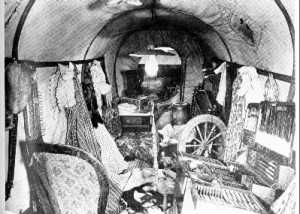
Inside the covered wagon
That morning, she had already burned her hand on the boiling coffeepot perched precariously on the burning wood, and mourned when she realized she had forgotten to wash her hands before flattening the biscuit dough.
After breakfast, she had to scrub out the skillet, repack the wagon, rock the baby back to sleep and begin driving the wagon while husband James searched for buffalo. If he did find meat, she would be forced to help him skin and butcher.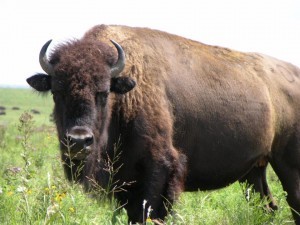 Then she would have to change into her second dirtiest dress, wash her hair and douse it with kerosene.
Then she would have to change into her second dirtiest dress, wash her hair and douse it with kerosene.
Buffalo carried lice in their wooly fur.
When the train finally stopped for the nooning, Abby looked around and saw a hill where she could hide while emptying her bladder.
The miracle happened when she squatted and glanced to the side. The blackberry bushes appeared, to her, like the Burning Bush appeared to Moses.
Fresh berries! Blackberry pie. James and Horace would be so happy. She personally longed for every fatty bite.
So after rubbing her back she stooped to the bush, filled with fresh determination. 
Sensing a movement, Abby turned her head and almost fainted.
An Indian woman walked over the hill and froze when she saw Abby. She held a woven basket against her body and a big-eyed baby peered from a cradleboard strapped to the woman’s back.
Abby didn’t know what to do. It was hard to think. Two months ago they passed burned-out wagons. Indians.
Men talked about Indians all the time and advised each other to “Hang on to your scalp.”
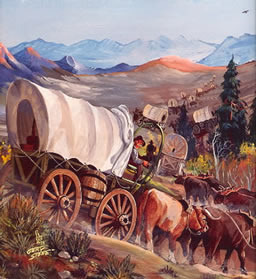 Should she scream? Turn and run? Did the woman have a man with her, or dear God, the entire tribe?
Should she scream? Turn and run? Did the woman have a man with her, or dear God, the entire tribe?
It was so hot in the sun.
At that moment, Abby’s eyes wandered to the berry bush and the berries were still luscious; succulent, seductive, sweet. She could taste that pie.
Before she knew what she was doing, Abby’s hand wandered to the bush, picked a berry and dropped it into her apron.
Still frozen, the Indian woman stared.
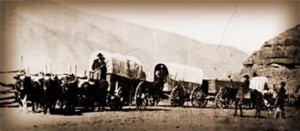
Wagon Train
Abby couldn’t help herself. The berries shimmered in the sun and she could smell their acidic odor. She kept picking.
The Indian woman’s baby yawned. The Indian woman’s hand reached out and pinched a berry, dropping it in her basket.
Carefully, the two women looked away and began picking more berries.
It was quiet. A meadowlark flew from the grass, singing.
One cup to go.
Soon, the women were only feet apart. Abby looked down at her grimy dress, feeling her skin crawl–the men would not stop the wagon train so the women could wash–and compared it to the Indian woman’s clean buckskin dress.
Fringe fell from the Indian woman’s sleeves and the bottom of her dress, and her buckskin moccasins were decorated with red and blue beads.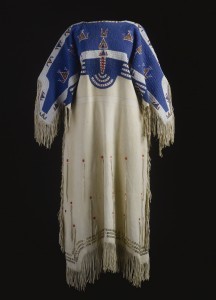
“Name?” Abby asked, longing for the buckskins.
The Indian woman didn’t understand. She shook her head, careful not to stand too close to the White woman.
Abby pointed to herself and said her name, carefully, with two distinct syllables: “Ab-by.”
The Indian woman half-smiled, pointed to herself and said, “Kimani.”
“What tribe do you belong to?”
Kimani shook her head. Her braids fell to her hips, shining blue-black in the sun.
The woman smiled and shook her head. She pointed to herself: “Ne’we.”
“Ne’we?” Abby had never heard of them.
“Children?” Abby asked the woman.
Kimani shook her head.
Abby pointed to the baby and flung her fingers out in a numbering gesture. Kimani showed three fingers.
She has three children!
James called her name. He was at the bottom of the hill, climbing toward her.
Abby turned back to the other woman and pointed down. “I have to go,” she said.
Kimani arched her back and rubbed it, frowning in pain. She raised her eyebrows at Abby, smiling an inquiry.
Abby arched her back and rubbed it, smiling back. 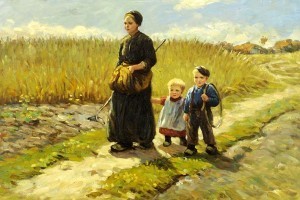
SECOND SUNDAY OF MAY, by Patty Wiseman
Anna balanced one-year old Eliza on one hip, wooden clothespin’s at the ready in the pocket of her homespun cotton dress. The summer of 1916 was a particularly hot one, but hot or not, laundry needed doing.
Little Alice struggled to carry the straw basket full of sheets, dried in the morning sun, to the house.
At five years old, the oldest child in the Walker household knew her chores well and carried them out without question.
Mrs. Walker watched her first born with pride as she disappeared into the house. This moment of idleness came to an abrupt end as an ‘all too familiar’ rattle turned her attention away from the house.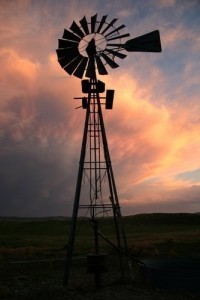
In the desert dust, a diamond back rattlesnake semi-coiled, warned Anna she was in its path.
Snakes were common, a nuisance to homesteaders. A quick glance toward the door assured her Alice remained out of reach of the predator.
“Stay there, child.”
In the next instant, she wrapped a sun-weathered hand around the garden hoe propped against the clothesline post, flicked her wrist, and chopped the head off the carnivorous reptile. She flipped the hoe and grabbed it by the business end, slipped the handle under the dead snake, and carried the intruder to the fence, tossing it out of sight.
“You can come out now, Alice.”
She swept a stray lock of hair from her brow, fished a clothespin from her pocket, and continued pinning the laundry to the line. The baby gurgled on her hip.
“Hand me the other pin, dear.”
The child reached into the large pocket of her mother’s dress. With amazing dexterity, Anna managed to pin the other end with one hand. The laundry was done, the baby put down for a nap, and Alice was ready for her lesson in bread making.
Dinner must be ready for her husband when he came in from the field. Anna was a homesteader’s wife. It was her duty to teach her daughter’s what that meant, but more importantly, to teach them how to survive in this difficult environment.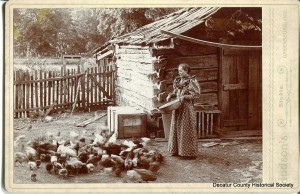 Bread making was a special time for her and little Alice. They giggled while pushing both hands into the sticky dough. Mother and daughter enjoyed this special time together, and Anna made sure a measure of fun was incorporated in the teaching method.
Bread making was a special time for her and little Alice. They giggled while pushing both hands into the sticky dough. Mother and daughter enjoyed this special time together, and Anna made sure a measure of fun was incorporated in the teaching method.
The bread baked in the oven filling the rustic house with a delicious aroma.
It was time to take a break. In the cool cellar beside the house, they chose a jar of homemade preserves to accompany the evening meal.
Anna made sure she lingered for a few minutes to give Alice a chance to savor a moment out of the afternoon heat.
While Alice napped, Anna sat in the rocker darning her husband’s socks. It was time to reflect on times gone by; remembering the loving teaching of her mother, sharing the tools she would now pass on to her daughter.
Her husband S.G. came home covered in dust, his weathered face smiling as he sniffed the air. “Something sure smells good.”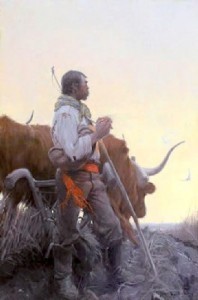 “Alice made the bread tonight.”
“Alice made the bread tonight.”
“You are teaching her well, Anna. I am always thankful you are such a loving mother and wife. This life ain’t easy.”
“Oh shush, S.G. and get yourself washed up for dinner. The children will be awake and ready to eat.”
“You’re a good woman, Anna Walker.”
The young wife blushed in the dimness of the living room. The family of four sat around the wooden table enjoying the meal prepared by two of the females in the house and provided by the young S.G. Walker’s hard days in the fields. “Oh, before I forget. Happy Mother’s Day.
“Oh, before I forget. Happy Mother’s Day.
He stepped outside and brought in a small bunch of wildflowers. “I came across these posies in the field. I thought they were fittin’ for a beautiful woman such as you.”
A warm flush came across Anna’s face. It was such a small gesture, but one that made all the hard work so very worthwhile.
Pioneer women—a breed apart, but the embodiment of what Mother’s Day is all about. Mother’s teaching their children, giving them the tools to carry with them to survive.
Mother’s Day on the second Sunday of May was signed into law by President Woodrow Wilson in 1914.
There have been many examples of extraordinary women throughout history, selfless mothers who sacrifice unbelievable hardship for their children.
It’s not just another holiday for gift giving, it’s a celebration of the women who have gone before us, teaching, loving, guiding. Most of us can look back to grandmother’s who share stories of survival in times when modern conveniences were non-existent. We have become the women we are because of them. Celebrate their lives; pay it forward to your children. 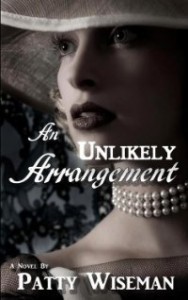
The post Mother’s Day–Stories by Wiseman and Robb appeared first on Julia Robb, Novelist.
May 3, 2014
Bad Hand–A Politically Incorrect Indian
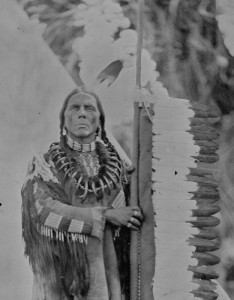
Bad Hand
The first time I saw Bad Hand, i.e. Apache Warhorse, he stood holding a lance, in a photograph, wearing fringed buckskins and a bear-claw necklace. He had two tall feathers in his hair and was the very image of an American Plains’ Indian warrior.
I saw the pix a few days after I joined The Order of the Indian Wars, a Facebook–based group (many of whom are historians) who discuss all things regarding that bloody carnage.
Apache Warhorse is a OIW member and considered a Plains’ Indian expert.
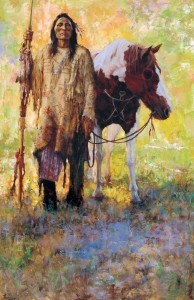
Bad Hand was a model for this image by Howard Terpning.
I was impressed. He said sensible and true things about Indian culture, attitudes and history.
For instance, he explained a few days ago that among some tribes, “a scalp hanging from your horse’s chin” meant “you and that horse (had in the past run) over a dismounted enemy….You could also paint on your horse’s chest a stick figure of a man. Amongst the Crow, to designate the same war honor, a red hand was painted on the horse.”
Useful stuff for an historical novelist (meaning me).
And he said: Indian warriors often agreed to scout for the U.S. Army because, among other reasons, “it goes back to that thing of being ‘professional predators,’ it is all they knew.”
Come to find out, Warhorse is a Seminole named Bad Hand (Apache Warhorse is his Facebook handle) and he does all things Plains Indian, including working in the movies as a stuntman, technical advisor, replica-maker and warrior trainer.
He also makes Indian regalia and crafts, models for artists who need an Indian man and speaks to groups.
Bad Hand’s book, Plains Indians Regalia & Customs, is informative and full of illustrations.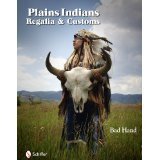
Bad Hand, 59, has lectured in more than 200 places, including the American Museum of Natural History, New York, NY; Charles M. Russell Museum, Great Falls, MT; Eastern Montana College, Billings, MT and Eastern Oregon University LaGrande, OR.
Bad hand also lives part-time in a tipi lined with scalps (but not taken violently, of course) and has definite ideas about modern Indian life.
Here is my Question and Answer session:
Q. Where were you born and where did you grow up?

Bad Hand’s tipi, lined with scalps.
A. Florida, I grew up in the Glades area way out until seven years old. Got married and moved to Wyoming when I was 19 and lived in a tipi in the wilderness for four years.
Q. You’re a Seminole, correct?
A. Yes a quarter.
Q. Where do you live now?
A. Oregon in the winter and in Wyoming, Montana, Colorado in the summer.
Q. You’ve been in the movies?
A. Yes, 44 films, TV shows, documentaries, etc. Dances With Wolves, Last of the Mohicans, Last of the Dogmen, on and on. 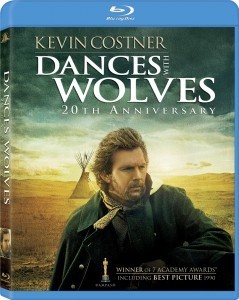
Q. How did you learn so much about America’s tribal peoples? You seem to know just about everything about everybody from the Apache, to the Comanche, the Northwestern tribes, etc.
A. Like anything just lots of reading, study, going to museums etc etc. There are no modern Natives or native groups that are generally even remotely aware of the real history.
Q. How did you learn the craft of making tribal objects, like the different projectiles, buckskin dresses, etc.?
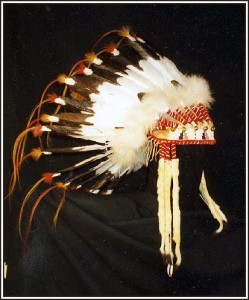
Bad hand made this Cheyenne head dress
A. Same as #5. (Just lots of reading, study, going to museums).
Q. You seem like a man who’s determined not to live like a victim, or consider yourself a victim.
A. You are correct. I make my own way, I have a working brain and capable body so do not need, want or expect help from anyone.
Q. Why do so many Indians (do you mind that name, Indian?) seem troubled, alcoholic, etc., or are those troubled people basically reservation residents?
A. No, Indian is fine. Unless non-Indians are around, most natives in the U.S. use Indian. Yes, the reservations often perpetuate only the worst in people and support an indigent lifestyle which is passed on from one generation to the next.
A Bad Hand creation
Q. Why do the people who live on the reservations have so many problems, such as the high percentage of alcoholics?
A. Because the system has promoted, allowed, encouraged reliance upon the government with nothing really done to promote real actual pride and self respect. IMO it is time for the Rezs to go away. Give the land to the families there and let them make their own way like everyone else.
Q. Is there a way to help these people?
A. Yeah see #11 (to end the reservation system).
Q. You don’t seem to have racial animus. Why? Lot’s of people do, including Whites who hold resentment against tribal peoples and African-Americans, and visa-versa.
A. Because I am an historian who views the world and its peoples as one, we all have the same fears, issues, desires, just different places, cultures etc.
Q. What was the most interesting movie you were in, and why?
A. Son of the Morning Star because it was about Custer’s Last Stand, because we killed soldiers every day for seven weeks in every conceivable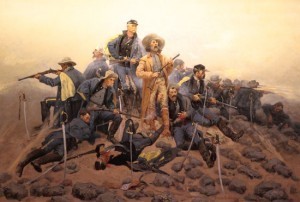 way and rode horses every day.
way and rode horses every day.
Q. Why was killing soldiers in the Custer movie and riding for weeks interesting?
A. Because most movies are pretty boring, sitting around watching actors trying to get their lines right!
Q. Are the scalps in your tipi real hair, or synthetic?
A. Real hair of course.
Q. Why did you make scalps out of hair and hang them on the inside of your tipi?
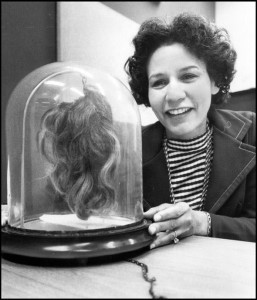
A real scalp
A. Because that is what would have been in a great warrior’s tipi!
Q. Since you are 75 percent White, why have you chosen the Indian way (to an extent)?
A. Who knows the answer to that or why anyone leans towards something. I always have been into it and history.
Q. Movies don’t seem to accurately reflect Indian life or culture. But maybe they don’t accurately reflect anything. Can you comment on this?
A. Bits and pieces of many of them do, but none have done it 100% right. Little Big Man is the closest to understanding and showing that lifestyle.
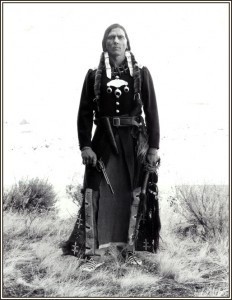
Bad Hand working as a model
Q. You have commented sometimes, in Facebook-oriented history groups, impartially, on Indian versus White issues (like, bad guys versus good guys). Are you impartial?
A. I try to be and try never to judge any one or groups in history, just observe them.
Q. Is there a good guy or a bad guy?
A. Nah, not IMO…good and bad on both sides and what happened to Native peoples was an inevitable thing. The world was growing and you could not stay isolated forever.
Q. You also seem skeptical regarding the reverential way many Whites view the American Indian.
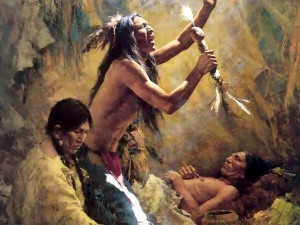
Painting by Howard Terpning
A. It is misguided but well meant sympathy and pity that I do not like, as it unwittingly serves no good for Natives and only helps perpetuate a loser mentality and promotes the whole indigence. That in turn prohibits or hampers growth and self reliance.
Q. I’m assuming you don’t live in a tipi full time.
A. Not any more, but I have quite a bit and do part time in the summer.
Q. You look a lot more than 25 percent Seminole. Why did you choose the Indian way of life versus the White way?
A. Well, if anything, it is the Old Way and not the modern Indian life. I move in and out of the real or modern world.

Bad Hand working as a model
The post Bad Hand–A Politically Incorrect Indian appeared first on Julia Robb, Novelist.
April 26, 2014
The Kirby Jonas-Julia Robb Short Story Challenge
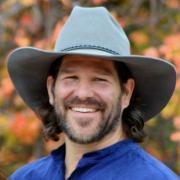
Kirby Jonas
When I came up empty for something to run Sunday at juliarobb.com, my website, I had an idea.
What if I wrote a short story and challenged friend Kirby Jonas to do the same thing.
Kirby is also a writer and currently has multiple books in print (the latest being Drygulch to Destiny).
Catch: We were limited to 800 words.
Kirby said sure, and wrote about a young man searching for gold. I wrote about Grizzly Jim Hawthorn, a dreamer who wants to be a mountain man.
I confess, I think I wrote 810 words while Kirby wrote about 797.
Read them and see if we entertained you.
Richest Man on the Mountain, by Kirby Jonas
I told Mama I’d be rich within a year. She didn’t believe me. Aunt Martha didn’t believe me. Even Jenny thought I was crazy. My own gal! Goes to show what women know.
From my viewpoint down here in this creek bottom, I could see little but the glitter of the largest vein of gold I had ever dreamed of.
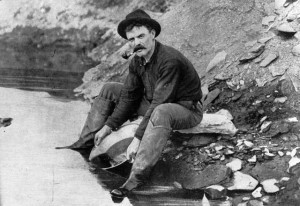
Man panning for gold.
The wind howled like a forlorn woman. Air as cold as Jenny’s feet swirled down into my shirt. Black clouds scudded across the sky, some with long tails sweeping down, bluish against the canvas-white of clouds behind them. Snow approached.
How much time did I have?
I looked at the gold in my hand. I had been in Colorado enough to see gold before, and lucky enough to be standing in the assayer’s office when some prospector weighed his in. The nugget was pure and gleaming yellow as any I’d ever beheld. It couldn’t have been worth less than five hundred dollars. I had clawed it off a ledge where it had fallen out of a vein in the side of the mountain.
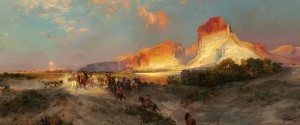
Green River Cliffs Wyoming, by Thomas Moran
No telling how deep that vein ran, nor how wide it might get inside the mountain, but to judge it offhand, on the surface alone, it shone like four or five thousand of the most beautiful dollars in God’s creation.
“I won’t get rich, huh, Mama?” Would she find out now! Her boy wasn’t as worthless as folks made out.
They had all laughed—menfolk too. Ab Jeeters, the bully of my childhood, had jeered and told me not only was I not going to get rich, but while I was gone he was going to steal my Jenny. Truth told, I was mad at her anyway, since she had no more belief in me than in a shredded Confederate dollar.
Still, I didn’t want to lose her—especially not to Ab, a man I still wanted to give back the gift of all the bloody noses he had ever given me in one pretty package.
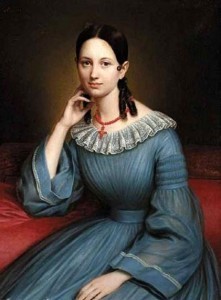
Jenny
I’m telling this to the wind, since she is the only one to hear me—her and the birds I see darting from branch to branch at the corner of my vision. I’m the richest man on this mountain! And here’s how this came to be . . .
I woke up on day three hundred sixty-four of my absence from Connecticut with an empty belly and ragged clothes. My boots were in tatters, and winter snapping at my heels. I had finally found me a rich creek. Panning it in my bare feet, so I wouldn’t ruin what remained of the fragments of my boots, I got me a stake. Maybe two-hundred fifty in dust. A long ways from its mother source, to be sure. Too far to think I had found me a mine.
But at least I could buy some food, and maybe some lumber, and build a sluice.
I saddled up my bob-tail mule—yeah, some corral mates had harassed her and chewed her tail near in two, picked on just 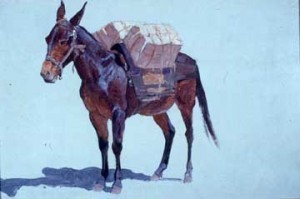 like her master—and I headed into town to buy supplies.
like her master—and I headed into town to buy supplies.
That’s when I met up with local thug Jig Hawley. And five of his men. They joked about taking my clothes, but they didn’t. They only degraded me some and then stole my mule and gold and left me alone and afoot.
I had nothing left, and winter kissing my neck. Tomorrow would be a year since I left home. I wasn’t rich. I was dead-broke. I would have no Jenny, no respect from Mama or my other relatives. No nothing. I was the exact failure they all claimed.
Well, they would never know. They could just wonder whatever happened to their dreamer. I found this cliff, and I started climbing, and I have no shame in telling you I meant to jump from the top of all hundred feet of that rock into this same creek and take my life. That’s what I was down to.
 So I got almost to the very top, all set to jump, and as I pulled myself over the rim, there gleamed the most beautiful sight in my whole life—and I think that includes my fickle Jenny. Thousands of dollars in pure gold, with nothing to do but pick it up and haul it out.
So I got almost to the very top, all set to jump, and as I pulled myself over the rim, there gleamed the most beautiful sight in my whole life—and I think that includes my fickle Jenny. Thousands of dollars in pure gold, with nothing to do but pick it up and haul it out.
I reached for that biggest nugget, just lying there, and before I knew it my feet slipped, and I found myself plummeting through the air. I landed in this creek on my back, and other than my head and my arms, I couldn’t move. Winter coming, me alone in a half-freezing creek, and with probably a million-dollar claim just waiting to be staked.
With a grim, weak smile, I let the gold roll off my fingers into the depths of a watery hole. Probably no one but the trout would ever see that gold again.
So, Mama, my claim came true. Tomorrow is a year, and I am a rich man—with gold to throw away.
THE END
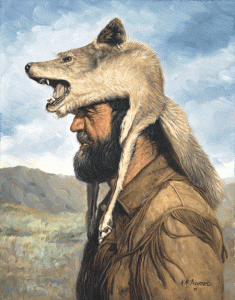
Mountain man, by Kenneth Freeman
The Rendezvous, by Julia Robb
Grizzly Jim Hawthorn swaggered through the Mountain Man Rendezvous, roaring “Nothing can beat this child, I’ll raise your hair, I’ll palaver you into the ground, I’m half-alligator, half-horse and all man.”
Jim was happy.
Re-enactors swarmed around him, between hundreds of teepees and campfires, costumed in fur hats, buckskin leggings, moccasins, beards down to their chests, muzzleloaders in hand and tomahawks on their hip.
Mountain men stooped over blankets covered with turquoise jewelry for sale, get your hand-hewn scalp poles and Arkansas toothpick knives.
In the competition, Jim was convinced he would load his rifle faster, and throw his tomahawk closer to the target, than any other mountain man.
In the meanwhile, the tanglefoot whiskey he guzzled from a jug lit his brain with white lightning.
This was an annual event and the only place Jim felt at home and never wanted to leave.
From Monday through Friday, 365 days per year, Jim toiled at his desk in Cleveland, Ohio, at “We’ve Got Your Back” insurance agency.
Kimberly had to commute further, so Jim got home first, fed the kids, plunked them in front of the TV and had dinner on the table when his wife walked in the door.
“Did you have a good day?” she asked him, nibbling Marie Callender’s (formerly frozen) lasagna.
“Well, I’m going to the gym. Can you put the kids to bed?”
“Sure.”
“I’ll just help you with the dishes.”
“I’ll do them.”
Truth was, he wanted her to go. The sooner she left, the faster he could pick up one of Louis L’Amour’s Sackett stories, the ones about the mountain men.
Or pop a DVD in the player, watch old Grizzly Adams episodes and plan where he would practice shooting his muzzlerloader.
Vivid dreams, in which he was the star, swam through his nights.
There he was, saving the wagon train from the Indians, guiding the whites through the mountains, dodging hostiles.
When he woke, he sighed, stared at his face in the mirror while he tightened his tie and tried to imagine one good thing which could possibly happen to him.
Kimberly wanted him to take her on a cruise, or just anywhere, Hawaii for God’s sake, she said.
But Jim counted the hours and days until he could leave for the rendezvous: Alone.
In the middle of his brag about being half alligator, Jim suddenly felt annoyed.
The enemy danced on the other side of the rendezvous. 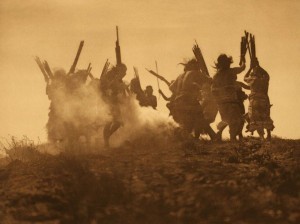
The Snake Indians, the Nez Perće, the Sioux and the Cheyenne were meeting for an inter-tribal pow wow.
He could hear the drum and see them stomping and swaying.
Nobody asked the redskins to the rendezvous, they asked themselves, he grumbled.
Trying to make white men feel sorry for what happened to them, those welfare queens, got their just deserts, lucky they’ve got reservations, and what about all the pretty ladies who lost their hair?
If I’d been there, I could have saved them, Jim thought, without asking himself who “them” was and what historic episode he was thinking about.
But Jim did know when he thought about fighting the red man he felt alive. He could feel the buckskin gripping his muscles and the tomahawk swaying at his side.
He ought to tell them a thing or two, he thought and strode toward the dancers, breaking them apart.
Indian men stumbled back, staring at him. The drum stopped.
“Come on dude, what’d you doing?” an Indian asked him, a young man with braids, a sleeveless sweatshirt and beaded moccasins.
“I’m laying the law down. I want you redskins out.”
Indian men began bunching toward him, dark eyes narrowing.
“This is our powwow, what the hell are you doing, you pussy white man?” an older Indian asked.
“Wait a minute, maybe he’s crazy,” the young man said, pushing the other Indians back with his arms.
“I’m the law west of the Pecos,” Jim roared, the joy of combat filling his heart.
Jim reached for his knife and before the young man could dodge, he brought it down and slashed the Indian’s bare arm.
“What the hell,” the young man exclaimed, scuttling backward and clutching his bleeding arm.
Seeing the blood, Jim felt a lightning bolt of joy hit him, and he remembered he had never taken a scalp.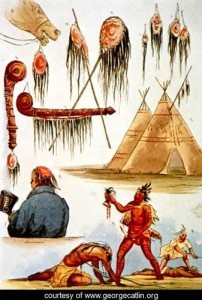
So Jim charged and grabbed the top of the young man’s hair.
It was an awkward position for scalping someone.
Before he could slash at the Indian’s scalp, the other men grabbed Jim, punched him in the stomach and face, forced him to the ground and yelled, “9-11, 9-11, police, help.”
Later, when Jim tried to explain what happened, he couldn’t do it.
He didn’t know.
The only thing he told the police, as they handcuffed him, was, “I’m half alligator and all man.”
The End
The post The Kirby Jonas-Julia Robb Short Story Challenge appeared first on Julia Robb, Novelist.
April 20, 2014
The Old West Was a Different Country
Here’s my confession.
 I don’t set my novels in the Old West.
I don’t set my novels in the Old West.
They’re set in Robbville; a place that looks and sounds like the 21st century’s version of the Old West, plus a lot of facts and a blast of my creative imagination; such as it is.
But it’s not the real Old West.
That’s because recreating any society is impossible. Societies are built from thousands of details that cannot be crammed into a novel.
In the Old West, for instance, people joked differently, used different slang, handled different objects, experienced different politics.
Here are a very few examples: Jokes in 19th Century America were corny beyond belief because society was corny.
People indulged in sex and coarse behavior in private (of course), but they never talked about it in public, and they never wrote about it in books, magazines or newspapers. And “nice” people didn’t curse around other nice people.
Hence jokes like this one. “How do you make a Maltese cross? By stepping on his tail.” Ha ha.
“How do you make a Maltese cross? By stepping on his tail.” Ha ha.
Names were different. More than half of all men used the initials for their first and middle names to identify themselves, and nicknames were much more common in the West than in the East.
Those names included Cattle Kate, Black Jack Ketchum, Dutch Henry, Billy the Kid, Calamity Jane, Texas John Slaughter, Pawnee Bill, Bittercreek Newcomb, etc.
Language itself was different.
Ron Scheer, at http://buddiesinthesaddle.blogspot.com, collects and publishes words used by 19th century Americans, particularly in the West, and here are a few of those words and where he got them.
Black-and-tan = derogatory term for someone of mixed race.
 “The way he gets a bullet onder that black-an’-tan’s left wing don’t worry him a little bit.” Alfred Henry Lewis, Wolfville.
“The way he gets a bullet onder that black-an’-tan’s left wing don’t worry him a little bit.” Alfred Henry Lewis, Wolfville.
Last run of shad = having a very thin, wretched, forlorn, or played-out appearance.
“I don’t think I could accuse him of being personal—I look like ‘the last run o’ shad.’” G. Frank Lydston, Poker Jim, Gentleman.
Flannel-mouthed = slow talking; loud; boasting; characterized by deceptive speech.
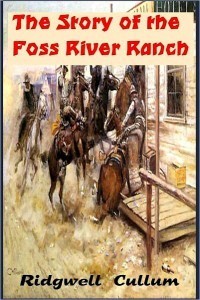 “You ask for dirty work to be done, an’ when that dirty work’s done, gorl-darn-it you croak like a flannel-mouthed temperance lecturer.” Ridgwell Cullum, The Story of the Foss River Ranch.
“You ask for dirty work to be done, an’ when that dirty work’s done, gorl-darn-it you croak like a flannel-mouthed temperance lecturer.” Ridgwell Cullum, The Story of the Foss River Ranch.
Deadfall = a rough saloon.
“Beware the pine tree’s withered branch, / Beware a ‘deadfall’, called Chalk Ranch.” William De Vere, Jim Marshall’s New Pianner.
When people traveled by train they said they were taking “the cars.”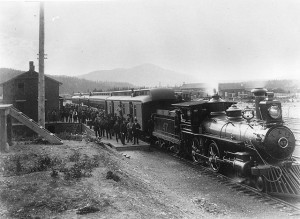
Physical stuff was different for Americans in general.
A hair wreath was a decorative wreath made from the hair of dead and/or living people. Hair wreaths were considered memorials.

Hair wreath
Headlines blared scandal then as now, but the scandals were different.
Ulysses S. Grant was elected president in 1868.
Shortly thereafter, people began talking about the “Black Friday” scandal which involved Grant’s brother-in-law.
It was a scheme to control the gold market. When the plot failed, it almost shattered the nation’s economy.
(The more things change, etc.)
The Whiskey Ring scandal involved Grant’s own personal secretary. The secretary, politicians, government agents, whiskey distillers and distributors, diverted liquor tax money to their personal bank accounts.

By Howard Terpning. Among the Spirit People
Americans fought among themselves politically in the 19th century, just like they do now; but over different issues.
Women campaigned for temperance, an issue they won in the 20th century when Congress passed the prohibition laws.
Elites in the East defended America’s tribal peoples and fought for their rights–much like Civil Rights’ activists worked for African-Americans in the 1960s’–while Westerners derisively called Indians “Lo,” short for the phrase, “Lo, the poor Indian.”
You can guess the difference in Easterner and Western attitudes.
Finally, no writer can replicate the silence. That deep silence, which covered 99.5 percent of the West, was something many western adventurers mentioned in memoirs, letters and diaries.
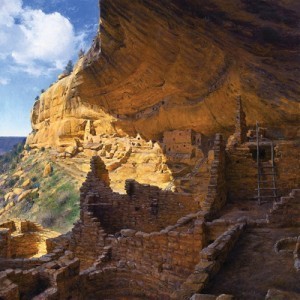
Enigmatic Long House, by Curt Walters.
It awed them. It seemed to make pioneers, soldiers, tribal peoples, explorers, cowboys and every other person who ventured into the wilderness, feel something mysterious, something powerful they could not explain.
Reading non-fiction histories is the best bet for visiting the West as it really was.
Here’s a list of some non-fiction books I’ve found helpful. 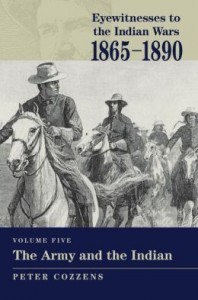
Author Pete Cozzens is an American treasure. Especially useful are his The Struggle for Apacheria, volume one of Eyewitnesses to the Indian Wars 1865-1890 and Conquering the Southern Plains, Volume 3, Eyewitnesses to the Indian Wars 1865-1890. Or you can buy an abridged volume simply titled, “Eyewitnesses to The Indian Wars: 1865-1890.”
You can take “Eyewitnesses” literally. Cozzens collected eyewitness accounts for these books and they are thrilling.
On the Border With Crook, by Capt. John G. Bourke, Fourth Cavalry, is the best frontier memoir ever written.
Bourke served in Arizona against the Apache and in Montana and the Dakotas against the Sioux and Cheyenne.
Bourke was an interesting man who expressed a great deal of sympathy for tribal peoples. 
After he retired from the Army, Bourke became a noted anthropologist.
Here’s another good one, Six Years with the Texas Rangers by James Gillette. Rooting, tooting.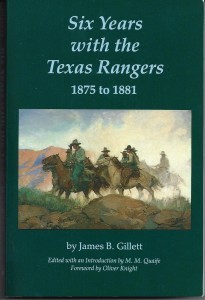
And if you must read some fiction about the West (beside my books), choose The Wonderful Country, by Tom Lea, Adobe Walls, by W.R. Burnett, My Antonia, by Willa Cather and The Color of Lightning, by Paulette Jiles.
It’s true you can’t completely recreate a time and place, but these authors came close. 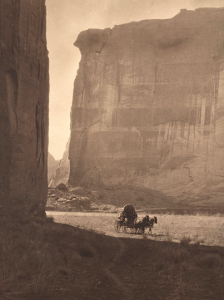
The post The Old West Was a Different Country appeared first on Julia Robb, Novelist.
April 13, 2014
Kirby Jonas Learned to Write Western Tough Guys by Being a Tough Guy
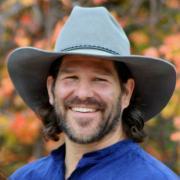
Kirby Jonas, western writer
Hi Kirby Jonas, what great stories. You grew up in the west (with a brief detour), you’ve written fifteen westerns, you were a police officer in Pocatello, Idaho, where you live, you fought forest fires for the Bureau of Land Management in five western states, once worked for the Idaho Fish and Game Department and currently work as a Poncatello city firefighter.
On top of everything else, you’re an artist and paint, or design, your own book covers. (Kirby himself posed for his newest cover).
Q. Was being a police officer good background for DryGulch to Destiny, your recently-released novel about a man hired to tame a lawless town?
A. Yes, it was supreme training for me to write DryGulch to Destiny. So many times I was in similar situations as my “hero,” Matthew Morgan. I once stood in the middle of a street during what amounted to a gang war, with a motorcycle gang on one side of the street and a black gang on the other, both of whom had sworn to kill the others on sight.
I stood there with only a pistol for protection, and a cadet cowering inside my patrol car to whom I had shown how to get the shotgun out and ready if he had to come to my aid.
Even knowing how badly the motorcycle gang detested cops, I turned and walked into their clubhouse, sort of like a mountain man having to choose between two Indian tribes that were both warlike. The place went as quiet as a tomb, and everyone turned to me in disbelief, standing there with my badge gleaming. When I asked who was in charge, a man suddenly spoke my name and came through the crowd. His name was Michael York–yes, just like the actor. I had once arrested him for domestic battery and taken him to jail.
But he had had an 1866 Winchester rifle at his house–the famous “Yellowboy,” or “Gun that Won the West,” and even though I was arresting him, we struck up a conversation. And because we both had a love for the West, we had an understanding. When I saw Michael there, not having seen him since I left him at the jailhouse, I didn’t know what to expect.
You might imagine the relief that washed through me when he loudly proclaimed to the other thirty or forty gang members there, “Hey, guys, this is a good friend of mine. He’s all right.” And the tension ran out of that room like water as a bunch of rough looking men came to shake my hand.
I was in many fist fights as a cop, several gun standoffs, and many situations where I knew I was going to die but obviously didn’t. So when Matthew Morgan walks into a crowded saloon in DryGulch and is confronted by his worst enemies, believe me, I know what is going through his mind.
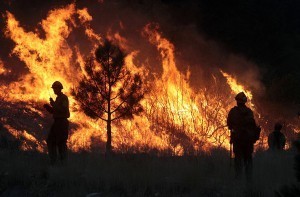 Q. You have fought forest fires, while working for the state, and are now a Pocatello fire fighter. Have you ever fought a fire that threatened your life?
Q. You have fought forest fires, while working for the state, and are now a Pocatello fire fighter. Have you ever fought a fire that threatened your life?
A. I have, unfortunately, fought many fires, mostly wild-land fires, that could easily have taken my life. But probably worse were the lightning storms when we would find ourselves up on some lonely, bald mountain in the middle of the night with lightning striking all around us, so fierce that we had to leave our metal tools far from us and lie down with only a sleeping bag for a shelter as the rain drenched us to the bone.
I have had a load of red fire retardant dropped on me, which has destroyed fire trucks on occasion, and I have lain trying to sleep in old, dead forests where we actually had to prop shovels up against the trees because the wind was so fierce we feared they would topple on us in the night.
There was one house fire, my first, where the chief was a friend of the owners, and he forced us to go into the basement before any ventilation had been performed, before the gas or electricity were shut off, and bare wires were hanging from the celling and sparking. There was ammunition in boxes that was burning and firing off, and honestly, I never thought I would survive that fire. And yes, it will some day be featured in a novel about firefighting–one of those things I survived and now consider one of the greatest gifts a writer can receive.

Kirby Jonas believes an uncontrolled wolf population is a “recipe for disaster.”
Q. You’ve said some interesting things regarding wolves to people who want them protected in all circumstances. They seem to feel wolves are noble creatures. I’d like to know your thoughts on that.
A. I believe the wolf is “noble” in some senses of the word. My favorite dictionary is Merriam-Webster, and one of their definitions says “grand or impressive, especially in appearance.” Other definitions can be stretched to fit as well.
Let me talk about the wolf. I love dogs, and I love the appearance of the wolf and the way they symbolize the Old West. The wolf is a loving father, a loving mother. And they are beautiful. Their throaty cries would symbolize, to me, the wilderness, every bit as much as a Canada goose call or the bugle of a bull elk. They are very adept at what they do, and besides frolicking with their family members, what they do is hunt.
That brings me to this truth: Under control, I believe that wolves are a beautiful part of nature. I like knowing they are out there.
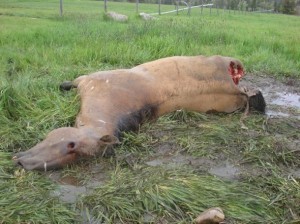
horse killed by wolves
But out of control, which wolves have become, they are a devastating force. They will destroy wolves that wander into their territory, they will destroy wildlife, not only to eat it but to train their young how to hunt, and simply for the pure enjoyment of the chase and the kill. They are no different than any other dog.
They get bored too. Anyone who thinks otherwise has not done their research and is “thinking” with their heart, and not their head.
 I respect and care about the wolf. My first dog was a wolf, my publishing company is named after wolves: Howling Wolf Publishing. I have sat on a snowy night, unarmed, in the wilderness of Idaho, howling with a pack of wild wolves that could have killed me if they had wanted to.
I respect and care about the wolf. My first dog was a wolf, my publishing company is named after wolves: Howling Wolf Publishing. I have sat on a snowy night, unarmed, in the wilderness of Idaho, howling with a pack of wild wolves that could have killed me if they had wanted to.
But wolves are growing ever braver and more accustomed to people, and they are growing far too numerous, more than the land can handle. It is a recipe for disaster. They have killed thousands of pets and left them lying. They have killed countless thousands of livestock, some to eat, some just for fun.
Wildlife has suffered greatly as well, and anyone who spends time in the mountains as much as I do has seen the carcasses of elk and deer they have killed and torn their entrails out, then left them to rot.
 My final say is this: Wolves are a wonderful part of nature, but because we, as humans, have come into upset the balance of nature, they must be managed like any other wildlife species.
My final say is this: Wolves are a wonderful part of nature, but because we, as humans, have come into upset the balance of nature, they must be managed like any other wildlife species.
Q. Can you be more specific?
A. In speaking of “wildlife management,” I mean sensible programs that control their numbers. I mean studies to monitor them carefully to make sure their populations don’t dip too low and also don’t grow too high. It pains some people to think of the “majestic” wolf being shot. It may pain them more to have wolves grow so numerous that their own dog is one day the next victim to fall to their jaws. Or a beautiful horse that is more like a pet.
Those who idolize the wolves need to open their minds and start looking at more in the news than just how wonderful and kind wolves are to their own cubs and mates.
Q. A grizzly attacked one of your characters in Death of an Eagle. That was electrifying. My hair stood on end. How did you research that?
A. Julia, as with anything I write, I delve deeply into my research, as deeply as possible. However, I have had characters shot, and I have neither been shot nor shot anyone else, although as a police officer I came far too close to both. As for the bear attack….. I have a gift I attribute to God for putting myself into any situation I’m writing about. In my head, I live it.
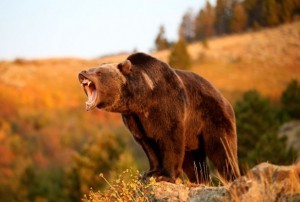
Grizzly bear
I spent hours and hours with our local grizzly bear celebrity at the zoo, watching his actions, taking in his odors, looking into his mouth as he yawned. I watched video interviews with men and women who had been attacked and read countless accounts of the same, both by those who survived and about those who didn’t.
I have stood twenty feet from a very large black bear with a Schrade knife with a six-inch blade, and Jose’s feelings about the grizzly were a magnified version of how I felt facing that big black bear, who outweighed me by at least 200, maybe 300 pounds and could have made short work of me if he had so desired.
Q. Do you hunt? I got the impression you’ve hunted grizzly.
A. I used to hunt. I honestly LIVED for the hunt. I would have horrible nightmares and wake up in a cold sweat because in my dreams I had slept in on opening morning of whatever hunt. I have hunted cottontail rabbits, Arizona javelina, deer, elk, moose, and yes, bear. But not grizzly.
 And then, over time, I grew to love wildlife so much that my hunting days just slowly “went away.” I remember an older gentleman telling me that the same thing had happened to him, and I remember my exact feelings. I thought that could never happen to me because it was such a huge part of my life.
And then, over time, I grew to love wildlife so much that my hunting days just slowly “went away.” I remember an older gentleman telling me that the same thing had happened to him, and I remember my exact feelings. I thought that could never happen to me because it was such a huge part of my life.
Then one day, at the same zoo where Charlie the grizzly lived, I got close to a mule deer fawn and put my finger through the chain-link fence–my trigger finger, no less. He began to lick it like a dog. Then the rest of my hand. I was mesmerized. He trusted me so completely, and he was so small and vulnerable. I never went out into the woods the same again, and that was the beginning of the end of hunting for me.
Q. I recently read about a man, a western writer, who believes he lived in the 19th-century west. Do you believe that kind of thing is possible?
A. I have to take a deep breath before I approach this subject. I generally don’t talk about this kind of thing with just anyone. But it has been coming back to me more and more over the last ten years or so, and I have this nagging feeling down deep inside me that perhaps I am missing something important, something my inner self knows and remembers, but my conscious mind does not.
 This began when I was writing Death of an Eagle. As you would guess, there is an eagle in this book. A golden eagle named “Golden.” There are other wild eagles mentioned, as there are in almost all of my books, but this is a special eagle that has been wounded by one of the trains my secondary protagonist detests so bad for bringing so-called civilization to his beloved wilderness.
This began when I was writing Death of an Eagle. As you would guess, there is an eagle in this book. A golden eagle named “Golden.” There are other wild eagles mentioned, as there are in almost all of my books, but this is a special eagle that has been wounded by one of the trains my secondary protagonist detests so bad for bringing so-called civilization to his beloved wilderness.
I began to research the golden eagle as I do with everything I write about, and part of my research took place at the same zoo where Charlie lived. There is a golden eagle there, and the first time I came up to study it closely and get to know it, it turned away from where it was to face me.
Now, mind you, there were numerous people around me, but that eagle zeroed in on me. This might seem fanciful, but it was very obviously true. Other people even came over and commented on how she was closely watching me, and only me.
Well, I was mesmerized. I couldn’t move. I was with a group of kindergarteners, including my young son Matthew and luckily my wife was there too, because when they moved on I could not go. I was transfixed.
Every time I have gone to see this eagle since, the feeling has been the same. I have no explanation for this, nor any explanation for how the goose bumps pop out on my skin and my hair stands up and my eyes fill up with tears each and every time I see a golden eagle out in the wild.
I won’t say that I was reincarnated from a golden eagle that lived in the “Old West,” but I will say that there is something there that I have no logical explanation for, a feeling deep inside me that goes far beyond learned schools of thought.
Did I live another life in the Old West? Feeling what I feel inside, I would never insist that this is impossible, even when all conventional teaching might say it is.
Q. Death of an Eagle sold very well. I understand it was a best-seller. But you’ve expressed disappointment book sales have declined. Can you tell us more about that?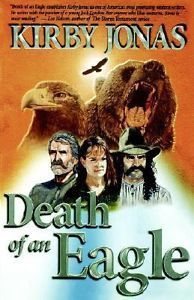
A. First off, I have fifteen books total, the first two out of print and the last three so far only on eBooks with Amazon. But twelve are in paperback.
Julia, my third book, The Dansing Star, started selling like crazy internationally, and I thought I was in heaven. But people who met me kept saying they wanted a book about Idaho–the state in which I now reside. So I wrote Death of an Eagle, another one of those gifts handed me by God, from beginning to end.
I actually lost this story once when my floppy disk went bad after chapter three, but a computer whiz (who was so good that he went to prison later for wrongfully using his computer skills) was able to bring it back and at least print it out, so that I was able to re-type the entire book.
Anyway, apparently all of those people chose to put their money where their mouths were, because it wasn’t long after releasing Death of an Eagle that I found to my astonishment it was the best selling Western in the country. I printed this list out from the Internet, where for just a brief time I was listed above Louis L’Amour, Elmore Leonard, Elmer Kelton, and every other Western writer I revered. I still sometimes have a hard time believing it was real.
The next year, my Legend of the Tumbleweed was the best selling Christmas-release book in the entire northwest for Waldenbooks. That includes some nine states and northern California. It was released about the same time as the new Harry Potter book, and mine beat it for overall sales.
Waldenbooks even hired me to be their keynote speaker at their next managers’ convention.
And then, sadly, Waldenbooks began to decline, as did B. Dalton, my two top sellers, and soon both were gone. Borders went with Waldenbooks, as they were basically one and the same.
And suddenly, in the absence of electronic books, I found the carpet jerked out from under me. Where I had been used to print runs of 5000 at a time, even second print runs, I found myself down to 1000, and I have even contemplated fewer. The world has changed for booksellers. Drastically. I am learning this new world from the ground up.

Golden Eagle
But I have regained the hope I once had, and I feel ready for the climb back to the top. Many people have told me that Death of an Eagle is the best Western they have ever read, and four have told me it was their favorite book of all time. I have people who tell me I am their all-time favorite author. How can I let these people down? It isn’t in me.
I have over one hundred more books outlined and just waiting to be written, so although the book selling world has changed, I am going to meet that challenge. I know there is no ceiling for the author who writes a good book and who is willing to adapt to a changing world.
The post Kirby Jonas Learned to Write Western Tough Guys by Being a Tough Guy appeared first on Julia Robb, Novelist.
April 6, 2014
Randy Eickhoff Writes Old West and Ireland
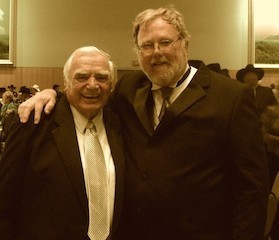
Randy Eickhoff with Ernest Borgnine.
Hi Randy Lee Eickhoff, thank you for talking to me.
My my, you are the most surprising and under‑the‑radar author I have ever discovered. In fact, you are so interesting I don’t even know where to start.
So I’m going to tell the reader the basic facts and use the questions to ask the when, where and how stuff.
You’ve written twenty books, some based on Irish myths, (you’re seemingly an expert), some of them historical novels set in the west (one based on Doc Holliday’s life), one is a novel about a returned Vietnam vet, seemingly based on The Odyssey, one is a new translation of Homer’s Odyssey, two are thrillers set in Ireland, two are thrillers set in Vietnam and one is a non‑fiction work about the history of the Tigua Indians.
Plus, you are a Vietnam War vet and have doctorates in philosophy and theology.
Tell me about your historical novels set in the old west. Why did you write them?
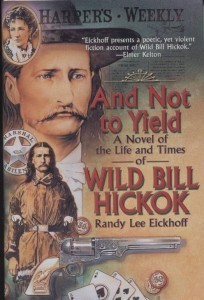 Randy Lee Eickhoff: Westerns have always interested me. I grew up in western South Dakota where, at that time, the West was still fresh—it hadn’t died out with the passing of time. I knew my great-grandparents and they had wonderful stories to tell. My grandmother even told me stories about how her father brought them to South Dakota to homestead. She remembered lying on the floor in a “hotel” and listening to flood water run under the floor.
Randy Lee Eickhoff: Westerns have always interested me. I grew up in western South Dakota where, at that time, the West was still fresh—it hadn’t died out with the passing of time. I knew my great-grandparents and they had wonderful stories to tell. My grandmother even told me stories about how her father brought them to South Dakota to homestead. She remembered lying on the floor in a “hotel” and listening to flood water run under the floor.
When they crossed the Bad River in their wagon, along with others, they laid timbers from one section of the ice to another until they managed to reach the other side. Just as the last wagon cleared the river and started up the bank, the ice broke!
I remember sitting with my great-grandfather and listening to his cronies tell stories about their youth. Some of them even knew famous people, such as the outlaw Doc Middleton.
One even told how he was delivering papers in Deadwood
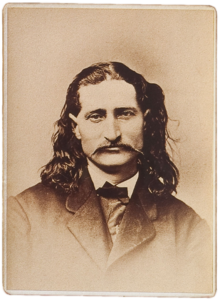
Wild Bill
the day Hickok was shot, and once Hickok even gave him a dime, which was a lot of money back then.
I realize now that some of those stories were a bit stretched, but there was truth in them as well.
I personally rode horses to help herd cattle as we couldn’t get into parts of the ranch with any vehicles.
I read all of Zane Grey before I even went into junior high school and many other authors as well. I even met some of them, such as Luke Short, who had a wonderful home in Aspen, Colorado, where he is buried. And he had time for a young boy, too, and told me stories as well.
So, I just naturally gravitated toward westerns.
I wrote them under my name and under a pen name as well.
Q. Which was your favorite, Doc Holliday, or Wild Bill Hickok, both of whom you’ve written books about?
A. Well, it’s hard to choose. Bill was very familiar to me as I lived in Hill City, in the Black Hills, which is only about 20 miles from Deadwood.
At that time, tourist season had yet to boom.
Shoot, I remember when going up to Mount Rushmore was over a dirt road! So, yeah, I liked the story of Wild Bill Hickok.
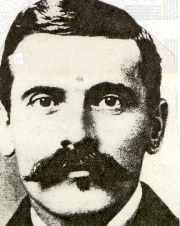
Doc Holliday
BUT I also liked the story of Doc Holliday and saw him as a metaphor for the West. His life was short, filled with action, and, consequently, people like him were, and still are, larger than life.
The West is rapidly becoming our central myth.
Funny. You’d think the Revolutionary War would be, but it’s not. It’s the Old West.
Oh, here is a little nugget on Doc Holliday. It seems that back in Georgia he fell in love with his first cousin and she with him. They planned to get married. But then Doc developed tuberculosis, which was regarded in the same breath as syphilis, and other “deviant diseases,” and her family broke off their engagement.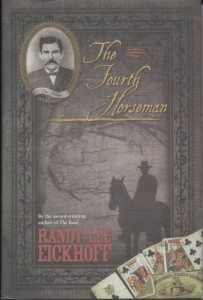
Doc went West. His cousin joined a convent and taught school. AND she was the teacher of Margaret Mitchell who wrote Gone With The Wind.
I’ve always seen that as a quirk in history.
If I had to pick one between (Holliday or Hickok), I suppose it would be Doc, as his life was tragic as he accepted his illness and rose, indifferently perhaps, above it, embodying both good and bad, the gentleman gambler and gunfighter.
Well, that’s the legend. The truth is that what we consider a gunfighter today was not a gunfighter back then. They were generally called “shootists.”
Doc was deadly, though, and none other than Bat Masterson said he was the most deadly and fastest man with a gun that he had ever seen. No small praise, that, as Masterson wasn’t any slouch with a pistol either.
 Some people think that I should say Bill, as my novel, And Not To Yield, won the Wrangler Award as Best Novel of the Year, which is the top award you can get for writing novels of the West. It is given by the National Cowboy Hall of Fame and Western Heritage Museum, which is one of the finest museums in the world and I have been to a lot of them!
Some people think that I should say Bill, as my novel, And Not To Yield, won the Wrangler Award as Best Novel of the Year, which is the top award you can get for writing novels of the West. It is given by the National Cowboy Hall of Fame and Western Heritage Museum, which is one of the finest museums in the world and I have been to a lot of them!
Getting that award is akin to receiving an Oscar.
At that banquet and awards dinner you meet many, many people. I met Ernest Borgnine there, and Tom Selleck. I knew Loren Estleman for years—who, incidentally, is a far better writer than I.
Others. I’m not trying to name drop here, but am simply trying to show how important and great an honor it is to be included in such company.
Loren has won three Wranglers, I believe, and every one of them well-earned.
Robert Carradine and I still write back and forth and talk occasionally on the telephone. You interviewed Dick Wheeler, who is a very good friend of mine and that’s one of the major reasons why I agreed to this interview.
Dick has won so many awards that the shelves in his house must be groaning from the weight. And every one deserved. He and Jory Sherman and, modestly, myself, do not write Western “thrillers” but rather approach our stories as literature.
In my case, these are two modern writers who had a great influence on the way I tell my stories. I try to show the true man with my stories. But now, when and if I go back to read what I have written, I see that legend and romance creeps in occasionally.
In fact, right now, I’m making plans to write another western, but that’s all I’m going to say on that matter.
It is too bad that a literary—what shall we call it, Snobbery?—denounces westerns as sub-standard writing, but there are great books that transcend the pulp western and are well-written and belong in that lofty strata of literature.
Dick Wheeler explained it best in a lecture and essay he wrote which is called, I believe, “I’m a Writer of Trash”.
He isn’t, of course. And as far as revealing history in a most exciting manner, you can’t beat Kathy and Mike Gear’s “People” series. Wonderful reads.
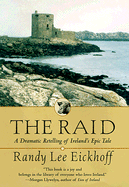 Q. Why did you learn to speak Gaelic? I’ve read your preface to The Raid and you’re an expert on Irish myth. Why did you become interested in Irish myth?
Q. Why did you learn to speak Gaelic? I’ve read your preface to The Raid and you’re an expert on Irish myth. Why did you become interested in Irish myth?
A. I learned to speak Gaelic because I wanted to read the Tain Bo Cuilinge, which translates The Cattle-raid of Cooley, in the original after reading, I think, three different translations.
Then, I decided that I wanted to do the translation myself. I was hooked by the story.
Unlike many other myths, The Raid is written not only in prose but some of it in poetic form as well. Very unusual construction. I discovered with The Raid, though, that this myth was reflected also in the Easter Rebellion which was the beginning of Ireland’s successful rebellion against Britain.
In The Raid, the hero is a boy, Cuchulainn, who is the fiercest warrior of the Red Branch (Ulster). The Raid was originally an oral myth in that it existed long before anyone wrote it down.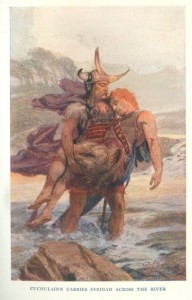
I can tell you…that this was a labor of love as I had to spend many hours in the Ancient Manuscript Room in the Old Library at Trinity in Dublin as I worked from the originals that had been gathered.
There were a lot of problems as the old language has many words that we still do not know the meaning of so we, translators and scholars, have to used educated guesses at what those words mean.
I ended up translating the entire Ulster Saga which involved years in Dublin.
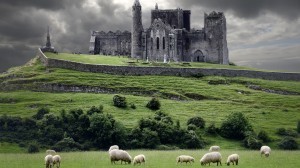 Ireland is a magical place. You visit it enough and discover that magical place stays with you forever.
Ireland is a magical place. You visit it enough and discover that magical place stays with you forever.
Q. You translated Homer! When did you learn classic Greek, and why?
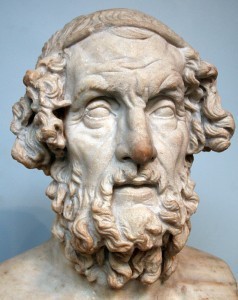 A. Again, I have always been fascinated by Homer but especially Odyssey. It is the second oldest extant work in the Western canon, The Iliad being the oldest.
A. Again, I have always been fascinated by Homer but especially Odyssey. It is the second oldest extant work in the Western canon, The Iliad being the oldest.
And, given the many different translations that exist, I was interested in what is considered the original. Although, I must add, we don’t have an original Homer manuscript. The oldest was put together by the Alexandrians.
 When Tom Doherty, my publisher, and Bob Gleason, my editor, learned that I knew Ancient Greek, which I might add is much different from Modern Greek, Tom decided that he wanted a new translation of Odyssey and asked if I would do that for him. The die was cast.
When Tom Doherty, my publisher, and Bob Gleason, my editor, learned that I knew Ancient Greek, which I might add is much different from Modern Greek, Tom decided that he wanted a new translation of Odyssey and asked if I would do that for him. The die was cast.
But, while I was doing the translation, I realized that much of the story, such as epic similes, could not be readily understood by the modern reader. So, I had to try and figure out a way to clarify some things as well. That’s why I not only translated the epic but also annotated it as well.
That caused another problem as the original is actually a long poem but a poetry translation, given what I wanted to do, wouldn’t work.
So mine is a combination of prose and poetry which, I think, works.
Besides, the poetic structure of the Greek is nearly impossible to duplicate in English.
At that time, it was the first translated and annotated translation, by the same individual, that didn’t force the reader to use other books for explanations.
At least, I hope my method worked. It seems to have as I have received a lot of favorable comments on it.
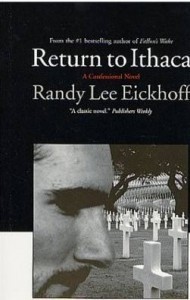 Q. Your novel on the returned Vietnam vet, Return to Ithaca, indicates the war was traumatic for you (as it was for so many others). Can you tell me more about that?
Q. Your novel on the returned Vietnam vet, Return to Ithaca, indicates the war was traumatic for you (as it was for so many others). Can you tell me more about that?
A. I was among the first to go into Vietnam back in March 1965. I was in the Airborne (paratrooper) and parachuted into various places. Before that, there had been some advisors but not on this scale.
Yes, it was very hard and traumatic. I was wounded in the Iron Triangle (we were told afterward that we were the first friendly forces to go in there in twenty-some years, but I wonder about that), awarded some medals, and that sort of thing, but managed to lock the experience away once I returned by using a memory palace–a mnemonic device introduced in ancient Roman and Greek teachings and writings.
It is a method of memory enhancement which uses visualization to organize and recall information but also can be used to lock unpleasant things away.
Unfortunately, when I grew older, I started having
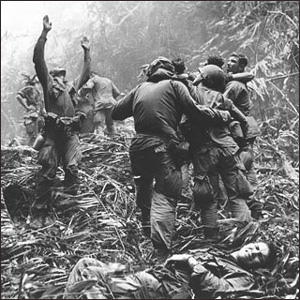
Khesanh Battlefield
nightmares about what I had done and the war itself and the walls of my palace began crumbling and finally I had to seek help for it.
I was at the point where if a car backfired I would find myself flat on the ground.
At that time, I was in my early fifties and when I went to the VA for help, my doctor said he was amazed that I could keep such an experience as I had undergone locked away for so long. But, things became worse and worse and finally I was forced to retire at fifty-four.
I’m still under treatment for PTSD and bi-polar along with many other problems.
I am very fortunate, though, in that I was rated a hundred percent disabled and thus can and do receive free medical care and free prescriptions.
I decided that perhaps if I could write about it that would help. So, I wrote Return to Ithaca, which took much, much longer for me to write than any of my other books. Much longer.
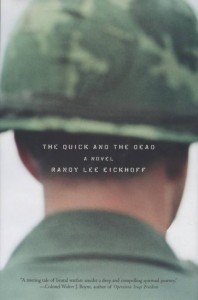 It is a novel but at least I would say half of it is based on my experiences. It did end up a best-seller, however, and led to another Vietnam book, The Quick and the Dead, which also has a bit of my experiences in it.
It is a novel but at least I would say half of it is based on my experiences. It did end up a best-seller, however, and led to another Vietnam book, The Quick and the Dead, which also has a bit of my experiences in it.
But, I still have nightmares and flashbacks from something that happened nearly fifty years ago. A long time to carry that around. A lot of people today do not understand why that is so but it happens.
We are seeing the same thing happening today, though, with soldiers returning from Afghanistan and Iraq.
Fortunately, huge advancements have been made in treating that disorder so more soldiers are getting help than before. They deserve it. They need it.
Q. How have you had time to be so prolific? It takes time to learn Gaelic and ancient Greek.
A. I’ve never really thought that I was prolific. I used to 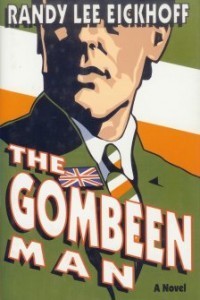 write on one novel in the morning and another in the afternoon. I felt that schedule always kept me fresh. Now, however, that is difficult mainly due to health. But I still try. One must always try. The alternative is not acceptable for me.
write on one novel in the morning and another in the afternoon. I felt that schedule always kept me fresh. Now, however, that is difficult mainly due to health. But I still try. One must always try. The alternative is not acceptable for me.
Yes, it did take time to learn Gaelic and Ancient Greek but if you truly want to learn, then no obstacle is insurmountable. And one should always approach such wants, which really are the need to know, with determination to succeed.
Both writing and learning require a lot of time but more than that, dedication. For me, especially. I hate being bored.
Q. Before running into one of your books and becoming  interested in you as a writer, I had never heard of you. Yet you’ve written all these worthy books (all of which, by the way, were published by publishing houses). You seem indifferent to marketing. Are you?
interested in you as a writer, I had never heard of you. Yet you’ve written all these worthy books (all of which, by the way, were published by publishing houses). You seem indifferent to marketing. Are you?
A. Yeah, I am indifferent, I guess. I do appreciate marketing but really think that is the purpose of the publisher. I do have a problem making appearances, though.
Part of that is that I am a very private person. Some have said that I carry this to extremes and liken me to Salinger in that respect. That is, my want for privacy, not talent! That is why I live where I do. Alone, in a house that really is too big for a single person (except for my golden cocker spaniel Mr. Lucky) and the house is on a small acreage.
I very seldom grant interviews as well. If I remember correctly, yours is only the second or third one that I have agreed to do. I am a very difficult person to live with although I have tried with a few live-ins, with all resulting in bad results.
Some people have said that I might as well join a monastery! I don’t know about that. I have a problem with authority as well. I guess my desire for privacy is the reason that few people have heard of me. But, for me, well, that works as I do not write my books so people will know me. I think the book should stand on its own merit.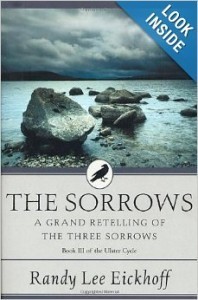
Yes, I do know that the more people know about the author the more likely they are to buy his or her books. I don’t like to think I’m anti-social, but I never have been very good with parties or sitting in a bookstore waiting to autograph books. I sort of consider that begging, please buy my books, that sort of thing.
And I really hate it when someone comes up and says, I have just written a book. Will you read it and tell me what to do? I’m sure all authors have had that happen and I think most of them get annoyed by that as well. So, yes, I suppose I am indifferent to marketing.
Q. Eickhoff is a German name but you seem fascinated with Ireland. Why?
A. (Laughs) Well, given my name that is a good question. I think it is because I see that the Irish have an enormous love of life and all that life entails. Especially literature.
Are you aware that before Ireland went to the Euro that the illustrations on their money were more related to the arts? Even their myths. Ireland is also one of the countries with a high literacy rate and per capita more books are sold than any other country. Their stories also reflect the influence of the past on the present.
And then there is their sense of humor.
 Once when I was sitting in a small pub a couple of older gents were sitting next to me and speaking in Irish, making jokes about me and Americans in general.
Once when I was sitting in a small pub a couple of older gents were sitting next to me and speaking in Irish, making jokes about me and Americans in general.
Finally I turned to them and said, in their language, that they came from a family of goats and at least I knew my mother. They became quiet then one of them suddenly stood up, pointed at me, and said loudly so others could hear, “We have a Yank here and he has the old tongue!”
I never had to buy another drink and I had so many pints that I couldn’t drink them all and finally left with quite a few standing in front of me!
The Irish have a word for that, “craich,” which is a form of humor that some may take as insulting but is really joking, in a good way, about another.
 Mainly, though, their myths are wonderful and originated as oral tales long before they were written.
Mainly, though, their myths are wonderful and originated as oral tales long before they were written.
Q. You grew up in Nebraska but now live in Texas. Why?
A. Actually, I was recruited by a Texas school to come down to Texas and teach. Since my daughter had just received a full scholarship offer from St. Edward’s University in Austin and elected to take it I thought that living in Texas would keep us somewhat closer.
Unfortunately, El Paso is a long, long way from Austin. I knew Texas was large very large, but I really did not know just how large it is. That, plus I was very tired of shoveling snow.
But then, I have also had a wandering foot and have a tendency to move around quite a bit. But I came to love Texas and the many different places in it.
Additionally, I have stayed in Texas because Texas treats its veterans better than most states that I know. The state holds its veterans in high regard and many privileges are granted to them. For example, veterans like me do not have to pay property tax.
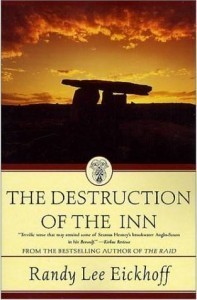 Q. You got two doctorates! Why?
Q. You got two doctorates! Why?
A. They came because I am interested in so many, many things and love to learn about them. And, as a writer, I can’t stand to be tied to one subject, which means a lot of research.
An incident happened which pretty much explains that. Once a writer friend threw a party to which my wife and I were invited. During that party, the hostess came over, sat on the floor and said, “Randy, I’ve read your books and you avoid sex in them. Why is that?”
I tried to explain that going into details about sex slows the plot down and, really, what is there new about it? That’s why, when it comes time for a couple to have sex I send them into the bedroom, close the door, turn off the lights, and pull the curtains and move on with the story.
My wife then chimed in, “Besides, my husband only writes about what he knows.”
We’re divorced, now.
Q. What are you working on now
A. I really don’t like to talk about work in progress. But, I am working on a new mystery that starts as a murder on an Indian reservation and another that is a mainstream novel.
I was translating Dante’s Inferno but only managed six cantos before I became interested in something else. I don’t know. Maybe I’ll eventually return to that.
The post Randy Eickhoff Writes Old West and Ireland appeared first on Julia Robb, Novelist.
March 30, 2014
Why Americans Need the Old West and the Art It Inspires

We not only need the Old West, we desperately need it.
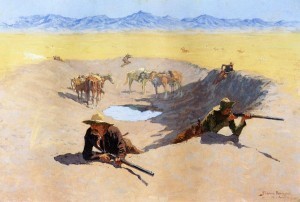
“Fight for the water,” by Frederic Remington
We need to dread an Indian attack and then grab a rifle and fight it out.
(Tribal peoples dreaded attacks by other tribes, as well as by whites).
We need to walk beside our wagon train, across the prairie, thirsty, hungry, tired and scared.
We need to stalk Tombstone’s streets, on our way to a gunfight, the way Wyatt Earp did.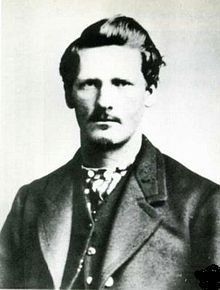
We need to live in a time when just getting through the day was a challenge–when people faced everything from rattlesnakes to backbreaking work that began at sunup and went on until the moon went down.
If we were really able to do these things, it would mean living fully, testing ourselves against nature, working with our bodies, venturing everything including, most of all, our lives.
And here’s why we need it.
Americans live a cramped and largely passive existence.
Many of us are bored. Law takes care of us (for the most part), government takes care of us (too much so, some people say), 9-11 takes over in emergencies.
Some people are so bored they take drugs, drink too much, or watch too much TV.

“Conjuring back the buffalo,” by Remington.
Our struggles are mostly emotional or financial.
Since Western culture is gone and cannot save us, the art it inspires will have to do. It has never been more important.
If we could not escape to the Old West (or into science fiction, or into a thriller or a mystery) our lives would be that much more restricted, like pecans shoved into nut-crackers.

by Remington
In some ways, this is a contradiction.
I’ve said we lead passive lives and then I said we need to escape into more passivity. Reading, for one, can be considered a passive activity.
But not really. Because when we read, we are using our imaginations, we are living second hand, but it seems real to us.
 Remember what it’s like to finish a book and feel utterly contented? We have fought our way through a situation with the protagonist–we WERE the protagonist–and now we can rest.
Remember what it’s like to finish a book and feel utterly contented? We have fought our way through a situation with the protagonist–we WERE the protagonist–and now we can rest.
Movies are passive, but here’s this. When we watch movies like “Rio Bravo” on DVD (God bless John Wayne), we let the movie folks supply the imagination but our hearts are released through the story.
Right resists wrong. Strong men and women fight a threatening enemy. And it was all up to them. No one saved them but themselves.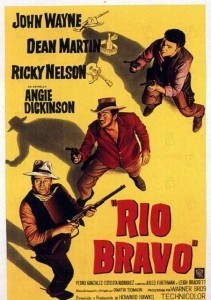
Every emotion we release, every need we express, through the book, the movie or the art, is heightened because the west was, once upon a time, a real place.
To humans, space is still a black void and thrillers are just entertainment.
But Montana is the place the Sioux and Cheyenne destroyed Gen. George Custer and more than 200 of his men.
It’s not a dream. It’s not space. Custer and his Seventh Cavalry troopers died above the Little Bighorn River.
We can visit the spot. Ancestors could have died there (on both sides).

Custer’s Last Stand, by Remington.
Born 150 years earlier, we could have died there ourselves.
It gives western books and movies an added edge.
So many of us long for western freedom.
Were they more free than we are? Really?
Yes. Men could settle their quarrels with their fists without being charged with assault. If they killed in self-defense, they walked free.
People could pick up stakes and move (if they survived) to a new land with new opportunities: You could pan for gold in California, you could round up the mavericks in Texas and head’ em north, you could pack a mule and traipse to the Rockies then trap beaver for a living.
 You could explore (like Kit Carson), you could become an Army scout (again like Carson) and spend your life tracking hostile tribes (if you kept your hair), you could leave Boston or Philadelphia and head west to teach school (become a school marm), etc. etc.
You could explore (like Kit Carson), you could become an Army scout (again like Carson) and spend your life tracking hostile tribes (if you kept your hair), you could leave Boston or Philadelphia and head west to teach school (become a school marm), etc. etc.
You could even become a painter like George Catlin and travel west, visiting more than 50 Indian tribes to leave a legacy of portraits for the future.
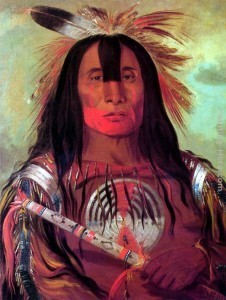
Buffalo-Bulls-Back-Fat, a chief of the Blood tribe. A painting by George Catlin.
Some women protest opportunities in the Old West were reserved for men!
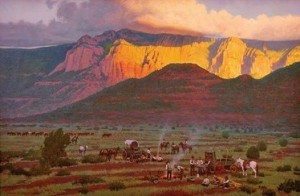 No, plenty of women fought side-by-side with the men and some took over when the men were killed, including many who ran ranches.
No, plenty of women fought side-by-side with the men and some took over when the men were killed, including many who ran ranches.
One Texas woman took her herd to Kansas.
Do I believe historical novels or westerns show us the real Old West? No. That’s impossible.
Societies are made up of so much, not just clothes, but customs no one remembers, social rules, jokes, medicine, political debates and words: “Nose paint” used to mean whiskey, according to Ron Scheer, at BuddiesintheSaddle.com.
But we can daydream through art, and some of us can write our flawed historical novels.
I once dreamed about the West, but at night.
I was walking across a wide prairie beside a covered wagon. It was spring and the sun was rising.
Miles of wild flowers covered the land in front of me and golden slopes loomed in the distance.
And this is what I saw.
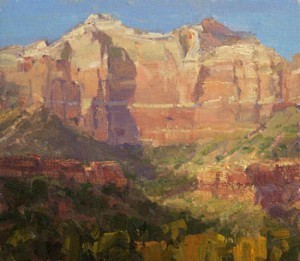
“Morning Zion” by Kathryn Stats
The post Why Americans Need the Old West and the Art It Inspires appeared first on Julia Robb, Novelist.

